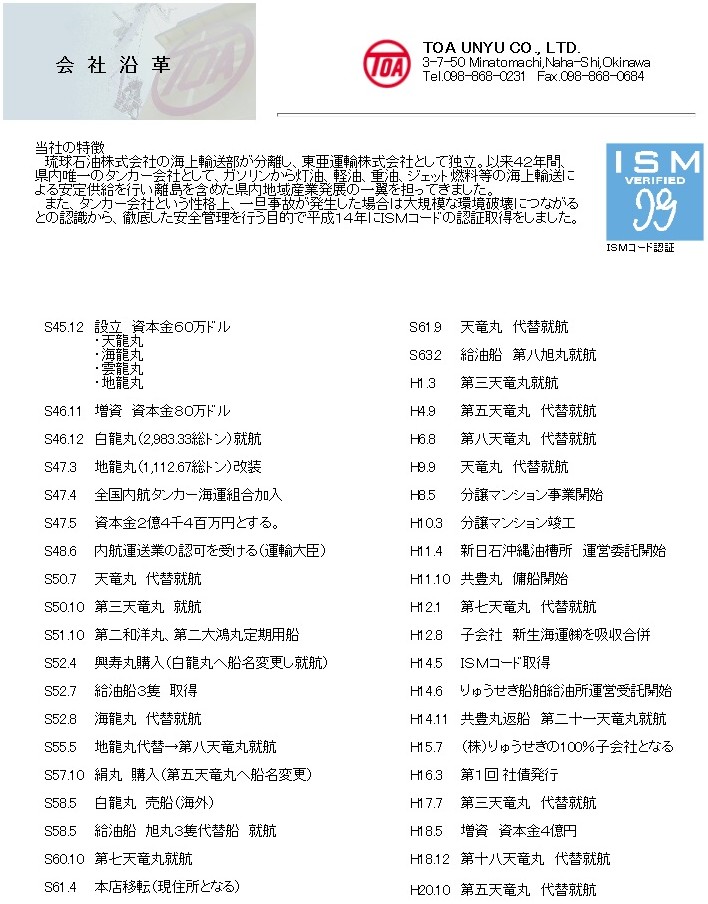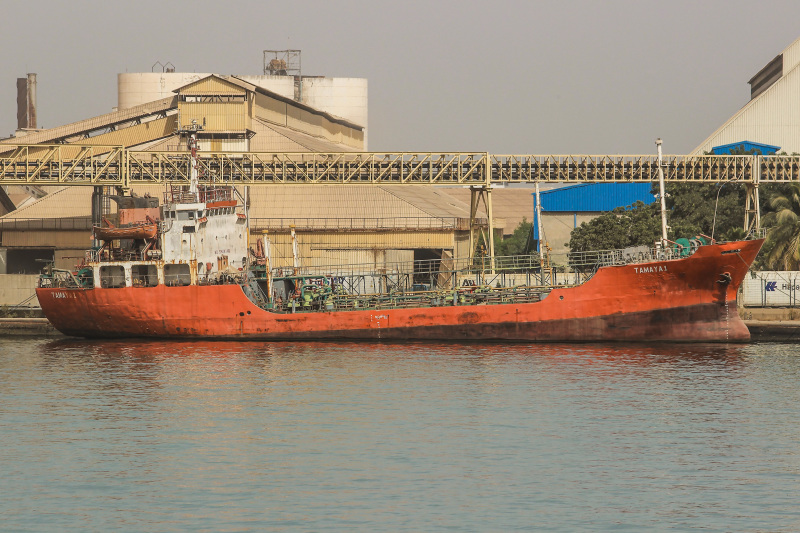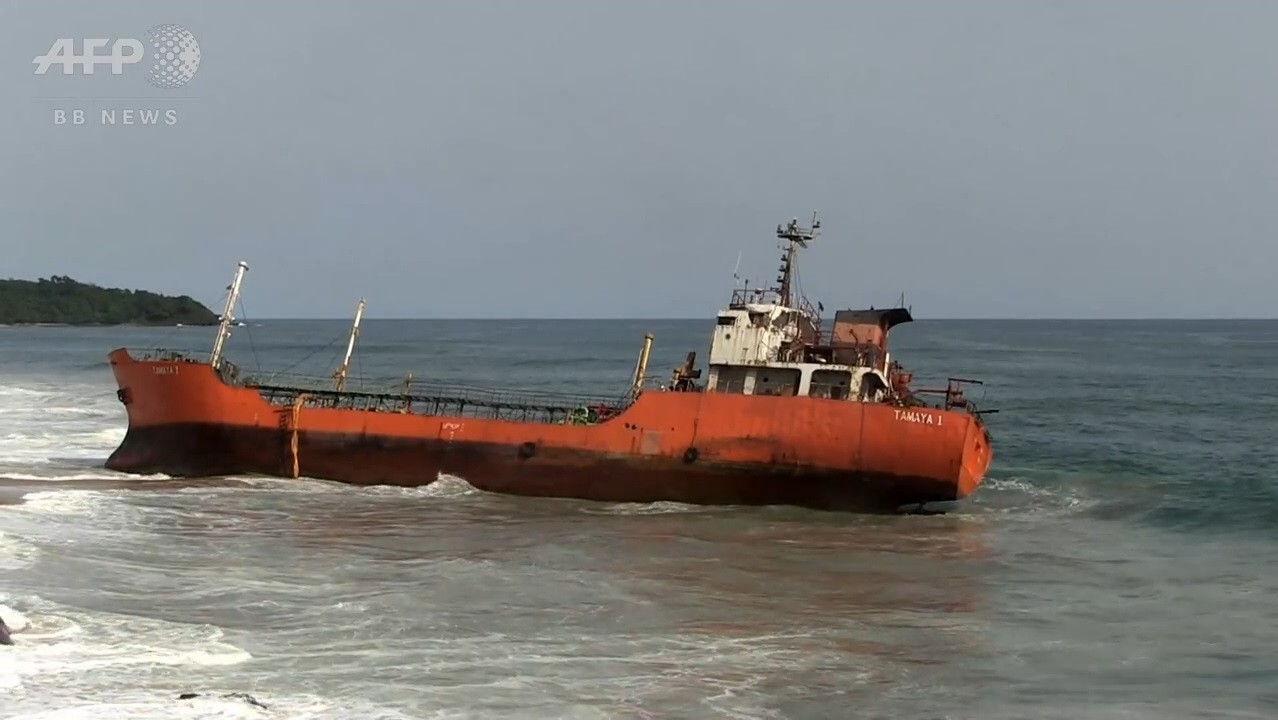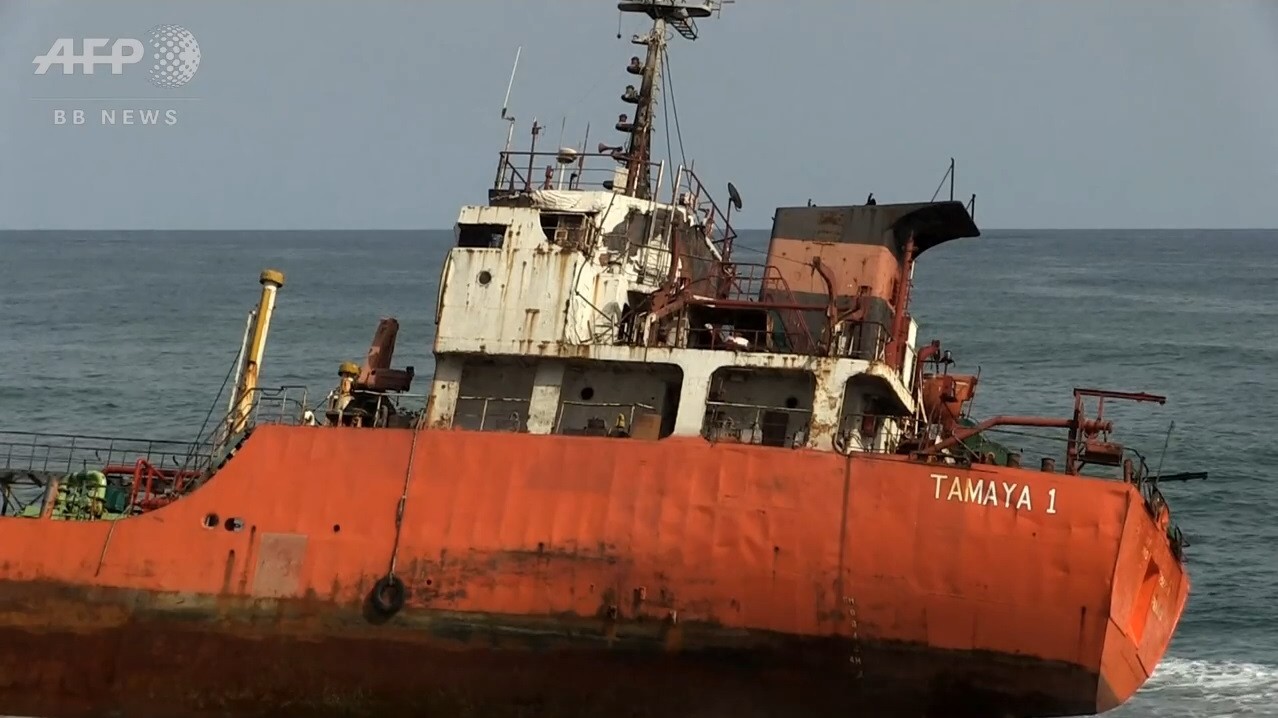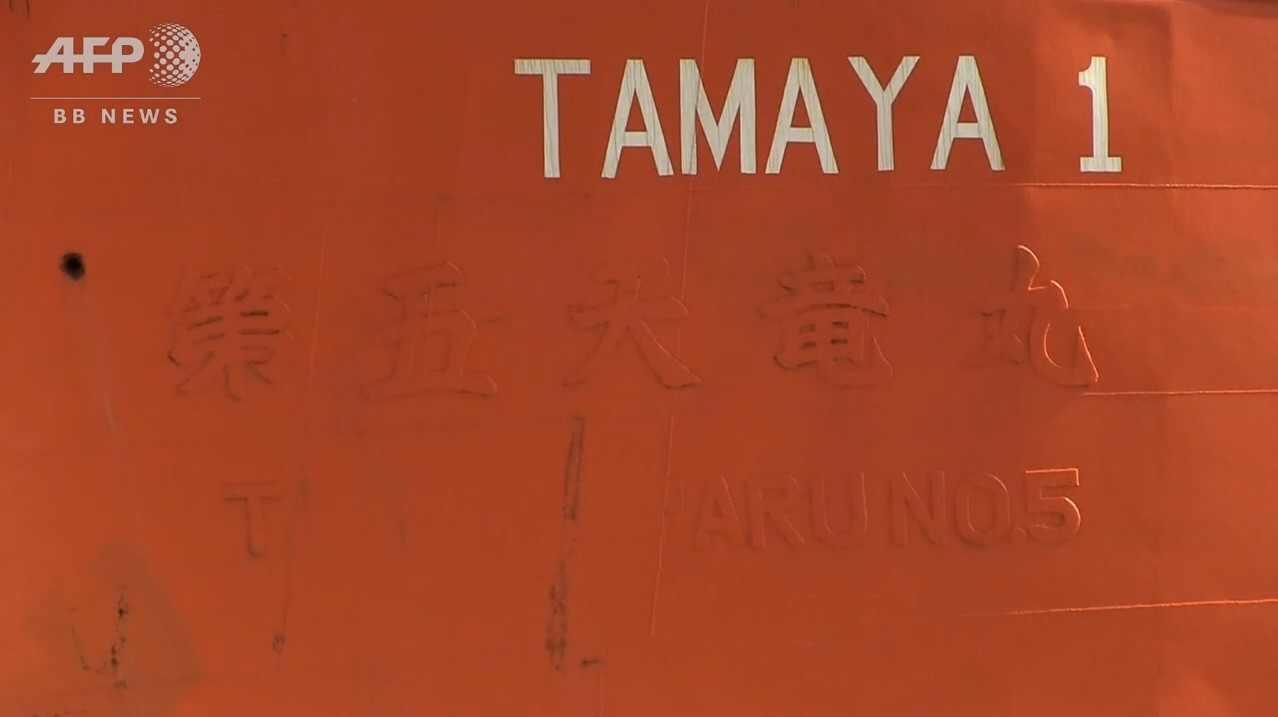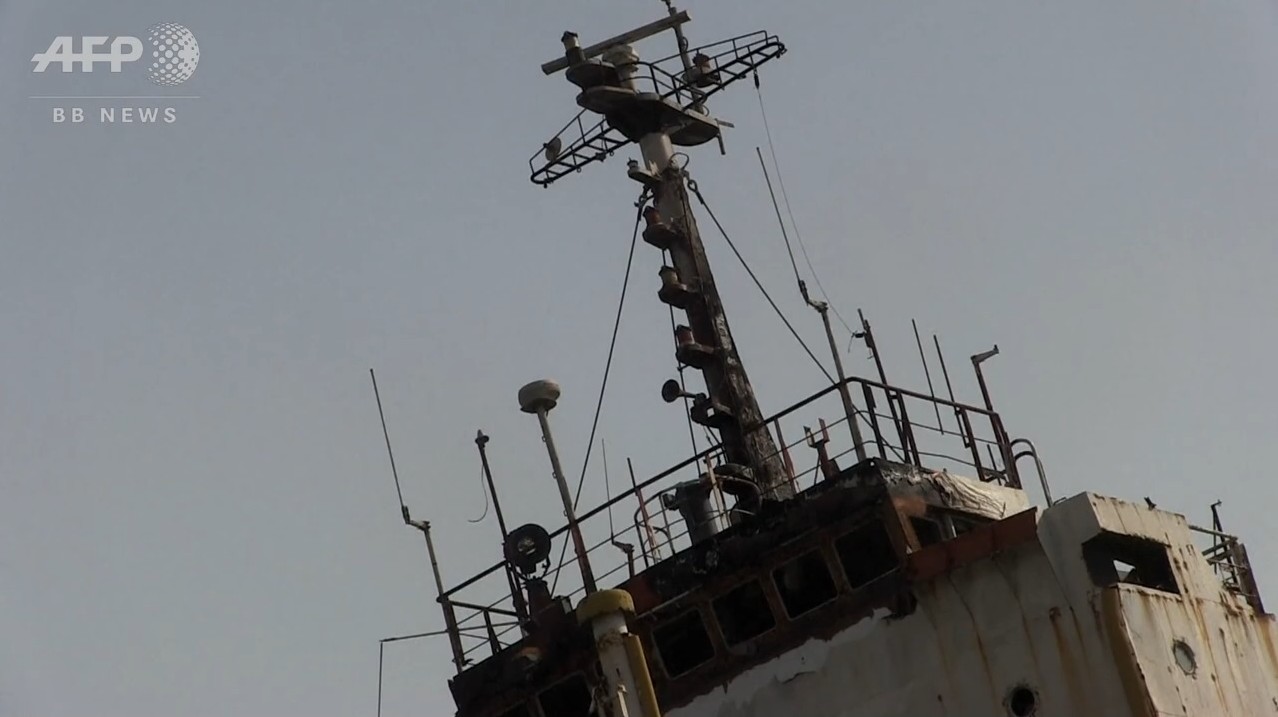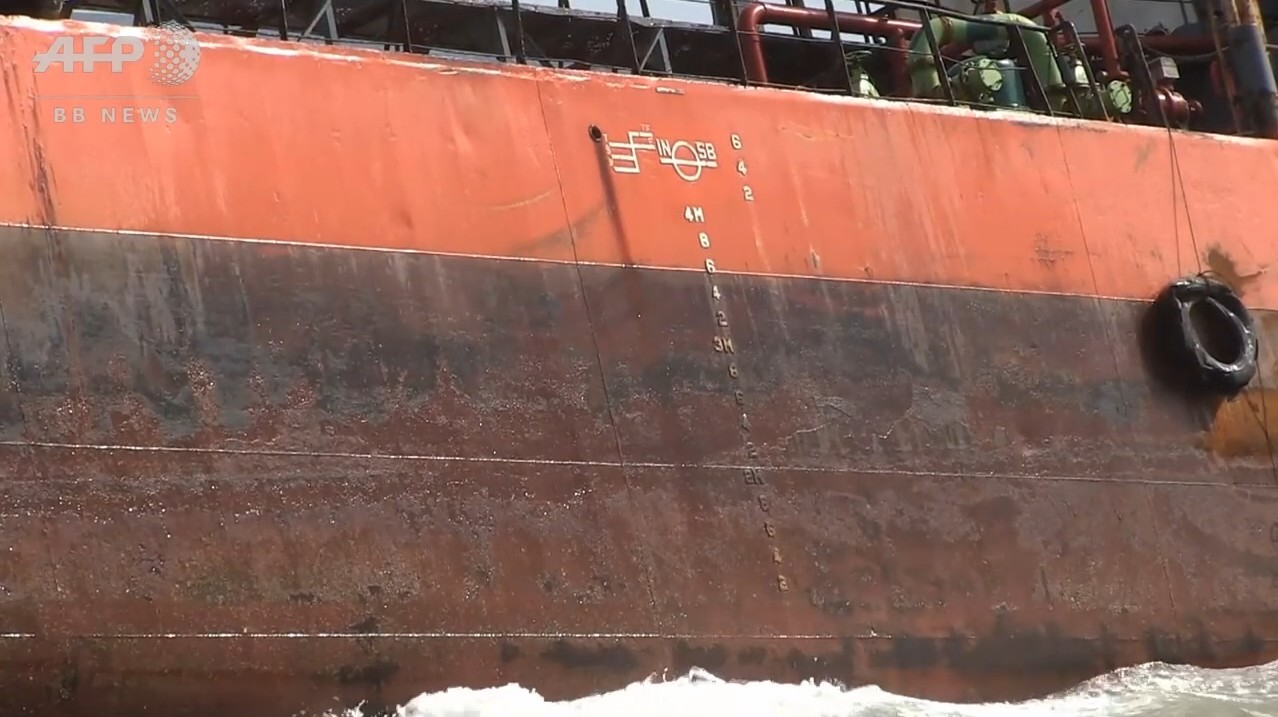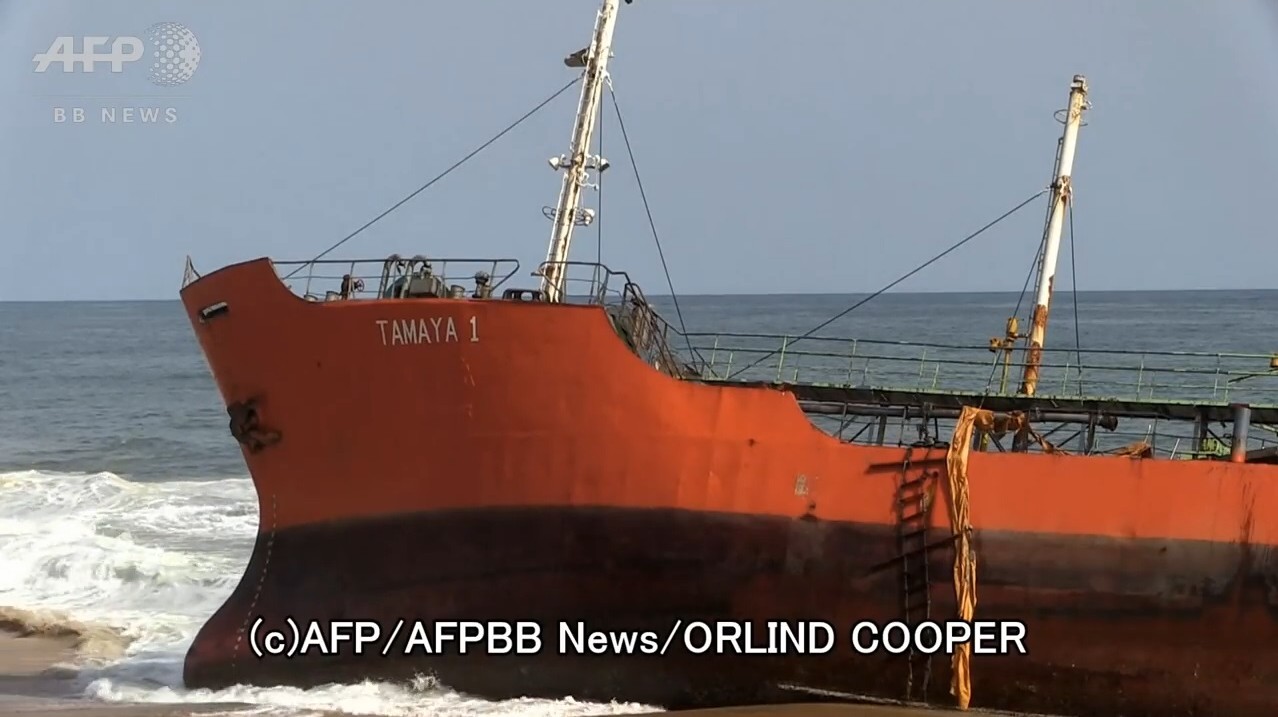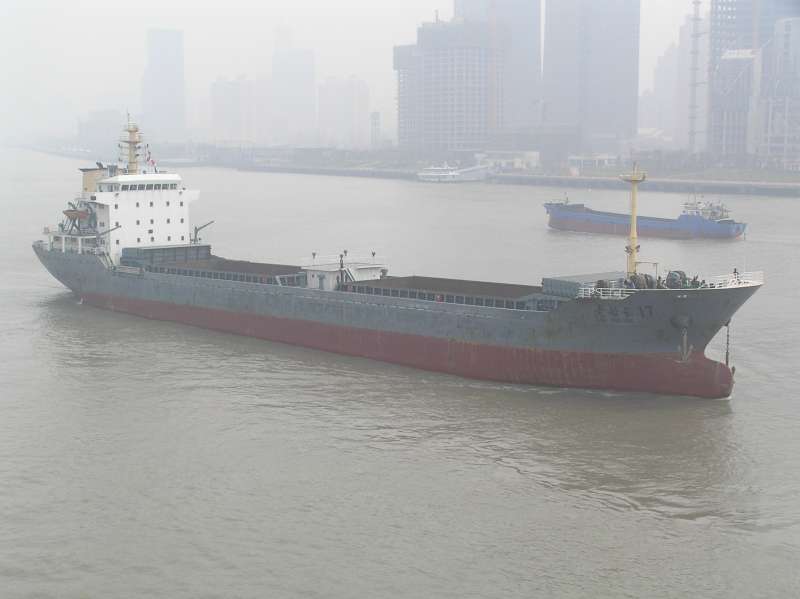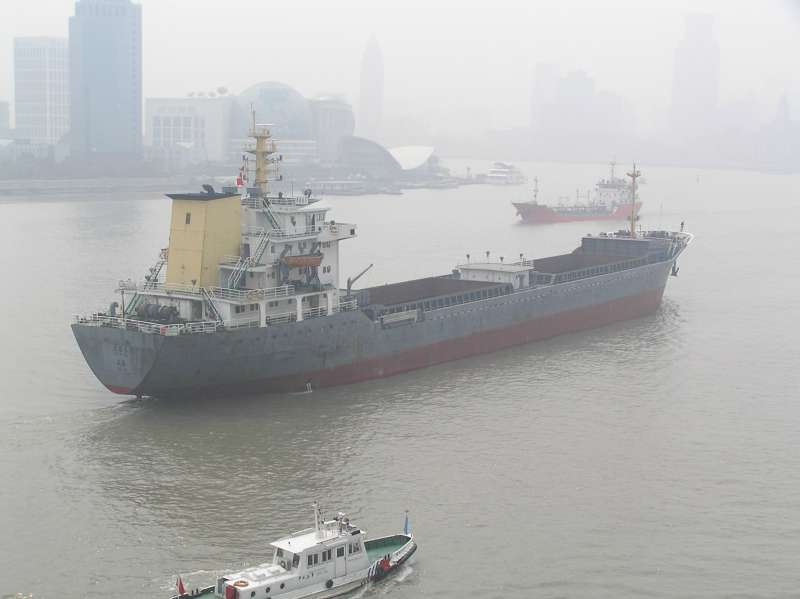無国籍船&幽霊船情報!
UNDER-PERFORMING SHIPS (1年間に3回以上出港停止を受けた船舶) TOKYO MOUのHP
Flag of convenience (便宜置籍船)(Wikipedia) ★企業の社会的責任
★中国から違法船続々! ★問題船は週末や夜に入港する ★元日本籍内航船サブスタンダード船
★船員免状の偽造及び問題 ◆海難情報! ◆海難2 ◆海難3 ◆海難4 ◆海難5 ◆海難6 ◆海難7 ◆海難8
 カンボジア籍船
カンボジア籍船
 トーゴ籍船
トーゴ籍船
 モンゴル籍船
モンゴル籍船
 シエラレオネ籍船
シエラレオネ籍船
 ツバル船籍船
ツバル船籍船
 フィジ籍船
フィジ籍船
 ベリーズ籍船
ベリーズ籍船
 ミクロネシア籍船
ミクロネシア籍船
 パナマ船籍
パナマ船籍
 不適切な検査:パナマ ビューロー
不適切な検査:パナマ ビューロー
 フィリピンでの船舶による油流出事故
フィリピンでの船舶による油流出事故
 ソーラー1(Solar 1)フィリピンで沈没!
ソーラー1(Solar 1)フィリピンで沈没!
 韓国客船 Sewol沈没
韓国客船 Sewol沈没
★悪質な造船所 ★神○造船の虚偽報告 ★常石造船からの報告? ★不適切な検査:パナマ ビューロー ★欠陥船根絶で監査制度試行
 タグボートMarina Iris沈没
★ 日本は甘ちゃん!違法天国!
タグボートMarina Iris沈没
★ 日本は甘ちゃん!違法天国!
★ 外国の事件及び外国人の事件5
第2回パリMOU・東京MOU合同閣僚級会議の結果について (国土交通省のHP) (サブスタンダード船の排除に向けた我が国の決意を表明)
海上災害の予防対策(総務省のHPより) PSCの検査について批判的な事実を書いている。
Shahjahan Ahmed
On July the 1st, the Sierra (IMO: 9522324), having loaded it’s cargo at Ust Luga, on the 28th June, was tracked approaching Gotland under the Malawi flag. The Aframax tanker, linked to the notorious “shadow fleet” has been under scrutiny by the governments of the United Kingdom (Oct 2024), European Union (Dec 2024), Switzerland and Canada (February 2025), because of it’s links to Sovcomflot, the largest Russian shipping company and linked to the state.
Investigations conducted by Lloyd’s List Intelligence and the Malawian High Commission have confirmed that the flag is indeed fraudulent and there is no authorized maritime authority backing it. Malawi is a landlocked country and despite having no coastline, or official registry, there are now four EU/UK Sanctioned vessels flying the flag.
The Sierra and other vessels frequently turn off or spoof their AIS transponders which confuses trackers and is a part of a toolkit used to evade regulators. The Malawi flag offers opacity with little to no oversight and allows for ease of reflagging with the use of digital registration. These are just a few of the tactics used by the “shadow fleet”.
This produces legal blind spots as flags are responsible for maintaining and enforcing safety and sanctions. Which means that by flying the Malawi flag there is no policing of the Sierra. Without proper oversight, the tankers pose both environmental and safety risks which is particularly apt in the sensitive Baltics. These trades also help bypass price caps and allow crude oil exports to destinations like India and China.
This is part of a wider strategy by the shadow fleet which includes shell companies, frequent ship to ship transfer, flag rotation, and AIS manipulation. According to analyses by the EU, nearly 17% of all global oil tankers now belong to these “Shadow Fleets”.
Along with the Sierra there have been the following suspect vessels:
Kiwala (IMO: 9332810): Detained by Estonia on April 11 while unflagged; held 16 days, released after correcting 40 deficiencies. The vessel has carried multiple names including Varuna, Odysseus, P.FOS and Virgo Sun, and flying Djibouti, Gabon, Mongolian, St Kitts and Nevis, Marshall Islands, and Liberian flags, since 2011.
Falcon (IMO: 9014432): No previous history of AIS spoofing, the LPG tanker entered the Gulf of Finland signalling its destination as Tallinn. However, Falcon’s AIS signal indicated that it had anchored off Estonia, while the tanker was loading gas in Russia. The Falcon has carried multiple names Such as Temse, Sabarimala Gas and Cumulus Gas flying Belgique, Panamanian, Indian, Liberian and Cameroonian flags, since 2011.
Blint (IMO: 9293002): Intercepted by Estonia in May under the name Jaguar; unflagged, accompanied by a Russian Su-35 jet incursion. The Blint has carried multiple names: Jaguar, S Puma and Signal Puma, flying Gabon, Mongolia, St Kitts & Nevis, Liberia, Malta and Marshall Islands, since 2011.
Udaya (IMO: 9288746): Entered Russian waters under cover of darkness on June 14 under the name Marathon after a slow transit through Estonia’s EEZ. Later exited the Baltic via Denmark fully laden, avoiding the English Channel. Has a history of using old identities linked to multiple ships. Flying Djibouti, Gabon and St Kitts & Nevis flag, since 2011.
Sierra’s switch to the Malawi flag is not a bureaucratic glitch—it’s a calculated move within a high-stakes game. By operating under a fake, landlocked registry, it skirts oversight entirely, enables sanctioned trade, and exploits loopholes in global governance. If the Baltic Sea is to remain protected, the international community needs to pierce this maritime mirage and hold the shadow fleet accountable.
IMO Secretary-General Arsenio Dominguez highlighted the shadow fleet and plans to improve practices for ship flagging in his first official visit to Panama.
Michele Labrut, Americas Correspondent
International Maritime Organization (IMO) Secretary-General Arsenio Dominguez made a first visit to Panama since he was appointed to the role heading shipping’s global regulatory body.
Panama is home to the world’s second largest ship registry, so it was no surprise that in official visit to his home country Dominguez focused on the shadow fleet and the ship procedures around the flagging of vessels.
“This is my first visit as Secretary-General to Panama, my country, so it is not only an honour, but also a great opportunity to meet with the Panamanian authorities and maritime associations and to share not only the issues that are currently priorities within the International Maritime Organization, but also to have the opportunity to exchange information, conversations, concerns, and any comments that I can offer to maritime associations, " he said.
Talking to Panama’s Chamber of Shipping, Domínguez indicated that the IMO currently focuses its actions on protecting seafarers and promoting global maritime safety, which includes combating piracy and threats in dangerous areas.
He pointed out as one of the organisation's main concerns the emergence of so-called “shadow fleets” which use third countries to flag their ships and thus evade international sanctions.
It is one of the most important issues in terms of maritime safety and that, although the IMO “cannot and does not wish to regulate the process of flagging ships,” it seeks to establish best practices so that this business is carried out properly.
“We cannot tell anyone how to register their ships, but we can ask each country to have better ship registration practices and to comply with international requirements,” he said, adding that in October, the IMO will revise and improve the practices of flagging ships.
The dark or shadow fleet of sanctioning busting vessels is a associated with frequent changes in flag often with obscure ship registries with a poor track record.
The Panama has taken a number of actions to tighten regulations of its ship registry including the automatic deregistration of sanctioned tonnage, no longer accepting tankers and bulkers over the age of 15 years, and rules for ship-to-ship transfers of oil cargoes.
Domínguez stressed that multilateral action is key to ensuring the safety of international maritime transport, preventing marine and atmospheric pollution, protecting seafarers, promoting greater inclusion of women in maritime careers, as well as complying with cybersecurity requirements and regulating the use of artificial intelligence in the sector.
Yip Wai Yee The Straits Times

This picture taken by Taiwan’s Coast Guard on January 3, 2025 shows the Cameroon-flagged "Shunxing 39" cargo ship sailing at sea. Taiwanese authorities are investigating the Chinese-owned cargo ship suspected of damaging a subsea telecoms cable northeast of the island, Taiwan's coast guard said on January 6, 2025. PHOTO: HANDOUT/TAIWAN COAST GUARD/AFP
The proposal comes after Taipei said that a China-linked cargo vessel, the Shunxing-39, damaged an undersea data cable to the north of the island on Jan 3.
TAIPEI – The recent severing of an undersea cable off Taiwan has underscored how important it is for the island to strengthen its communications resilience, amid concerns that the critical subsea systems connecting it to the rest of the world may become a target of sabotage in a potential conflict.
On Jan 15, Taiwan’s National Security Bureau said that it plans to step up the monitoring of ships flying so-called flags of convenience, referring to vessels that are registered to countries other than their owners’.
If these ships come close to undersea cables and enter within 24 nautical miles of Taiwan’s coast, the coast guard will board them for investigations, the bureau added in its report to lawmakers ahead of ministers taking questions in Parliament on Jan 16.
While such measures will be useful for now, it remains to be seen if they can achieve a strong enough deterrent effect in the longer term, according to Mr Ian Li Huiyuan, a military expert at the S. Rajaratnam School of International Studies.
“Such ships do exist for innocent reasons – for example, it could simply be cheaper to register a ship in a certain country,” he told The Straits Times. “So it may tax Taiwan’s ability to manage the situation if they’re having to monitor all flag-of-convenience vessels.”
The proposal comes after Taipei said that a China-linked cargo vessel, the Shunxing-39, damaged an undersea data cable to the north of the island on Jan 3. The ship sailed under the Cameroon flag and was also registered in Tanzania, but it was owned by a Hong Kong company, according to Taiwanese officials. All seven crew members on board were Chinese nationals, said Taiwan’s coast guard.
The incident caused minimal disruption to the island’s web traffic after Taiwan’s Chunghwa Telecom rerouted data to other cables, and there is no direct evidence that the damage inflicted was deliberate.
However the situation has raised concerns among the Taiwanese authorities of it being a possible act of sabotage.
“It is not possible to confirm the real intention of the vessel. However, we cannot rule out the possibility of a Chinese flag-of-convenience ship engaging in grey-zone harassment,” the Taiwan coast guard said in an earlier statement.
In response, China’s Taiwan Affairs Office said damage to undersea cables is a “common maritime accident” and that Taiwan was making accusations “out of thin air”.
Taipei has, in recent years, complained about Beijing stepping up its grey-zone warfare – the use of irregular tactics to weaken an adversary without resorting to open combat – in its long-term goal to pursue “reunification” with the island, which it claims as its own territory.
For instance, China has sent balloons and drones into Taiwan’s air-defence identification zone, aimed at intimidating the public and undermining the morale of the military.
Taipei’s alarm surrounding the Shunxing-39 came in the wake of a similar case in the Baltic Sea after a Chinese bulk carrier was linked to the severing of two undersea cables in Swedish territorial waters in November 2024.
In February 2023, the 14,000 residents in Taiwan’s outlying Matsu islands were knocked offline for several weeks, when the only two submarine cables connecting them to the main island were severed by passing ships flying Chinese flags.
The fact that the double damage was done in quick succession, with the second cable being severed within days of the other, startled officials.
In the case of the Shunxing-39, marine data tracking services showed that the vessel had sailed short laps in the waters near northern Taiwan since December 2024, which experts say is unusual.
“The ship made multiple ‘figure eights’ in the water, which could be an indication that it was dragging its anchor across the seabed to cut the cable,” said Dr Su Tzu-yun, a military strategy expert from the Institute for National Defence and Security Research, a Taiwanese think-tank.
If the act was indeed intentional, Dr Su said he believed it was designed to create unease among the Taiwanese public.
“If Taiwan’s undersea cables are completely cut off, its connections to the world are cut off,” he added.
International internet traffic is mostly carried through fibre-optic cables on the ocean floor, with Taiwan connected to the world through 14 such cables.
The cable that was most recently damaged is part of the Trans-Pacific Express Cable System, a nearly 18,000km-long system that connects Taiwan to the US, among other countries.
Damage to undersea communications infrastructure is not rare. According to the UK-headquartered International Cable Protection Committee, there are 150 to 200 cable faults globally every year, mostly caused by fishing and trawling, as well as natural hazards.
However experts are increasingly worried that the vulnerability of these critical systems – which could take weeks to repair if damaged and is a costly affair – could be taken advantage of amid heightened geopolitical tensions.
That is not a new idea. During World War I, the British cut German submarine telegraph cables to force the Germans to communicate on radio where it could be intercepted more easily.
Professor Geoffrey Till, an emeritus professor of maritime studies at King’s College London, said that the latest cable-cutting incident near Taiwan could be part of Beijing’s preparations for war.
“By cutting the cables, China can potentially test the vulnerabilities in Taiwan’s undersea cables, see the extent of network disruption and how long it takes for Taiwan to remedy the damage,” he told The Straits Times.
“As with all grey-zone tactics, it is not immediately clear that the state had instructed the commercial ship owner to cut the cables,” he added, which makes it difficult for affected parties to seek recourse.
Besides its plans to step up surveillance of passing ships, Taiwan has taken a leaf out of Ukraine’s handbook by setting up a backup satellite internet network for emergencies, which has proved to be crucial in keeping locals online amid Russia’s invasion.
So far, Taipei has placed 700 satellite receivers across the island, some of which have already proved useful after a 7.4-magnitude earthquake damaged telecommunications base stations in April 2024.
At the same time, Taiwan has embarked on an ambitious NT$4 billion (S$165 million) project to develop its own satellites to ensure backup connectivity during emergencies, with the first of two indigenous satellites to be launched into space in 2026.
But such satellite networks will not replace subsea cables anytime soon, given that the fibre-optic cables deliver much faster internet speeds, can carry higher traffic loads and are more cost-effective.
“If submarine cables are sabotaged, Taiwan would only be able to rely on bandwidth provided by satellites, which would affect our digital economy, international trade and banking,” said Dr Su, the defence expert.
“Taiwan needs to invest more resources in protecting the undersea cables.”
By Yimou Lee and Ben Blanchard
TAIPEI, Jan 15 (Reuters) - Taiwan will step up the surveillance and management of ships carrying flags of convenience, including boarding them, after a Chinese-linked cargo vessel was suspected of damaging an undersea communications cable, the government said.
Taiwan, which China views as its own territory, said a ship owned by a Hong Kong company but registered both in Cameroon and Tanzania, damaged a cable to the north of the island earlier this month, although it says it has not been able to verify the ship's intentions and was unable to board it due to bad weather.
The ship's owner has denied involvement, and China's government has said Taiwan was making up accusations before the facts were clear.
The incident has particularly alarmed Taiwan given it has repeatedly complained about "grey zone" Chinese activities around the island, designed to pressure it without direct confrontation, such as balloon overflights and sand dredging.
In a report to lawmakers ahead of ministers taking questions in parliament on Thursday, Taiwan's National Security Bureau said it plans to step up surveillance and management of ships carrying so-called flags of convenience, referring to those registered to other countries than their actual owner.
Such ships which have previously been found to misreport information about them will be put on a list of ships for priority inspection at ports, it said.
If these ships enter within 24 nautical miles of Taiwan's coast and are close to where undersea cables are, the coast guard will be dispatched to board them and investigate, the bureau added.
Taiwan will also promote greater international cooperation with the United States and Europe over suspected damage to undersea cables, it said.
"The bureau will continue to exchange intelligence with like-minded countries, collect threat alert information, analyse developing trends in sabotage techniques and false covers, and share prevention and response experience."
It did not give details.
Taiwan's coast guard, in its report to lawmakers, said its priority was to get access to the ship in question as part of its investigation and that areas where cable are located, and their landing points on shore, are key monitoring locations.
Yip Wai Yee The Straits Times

Xing Shun 39 off Taiwan (CGA)
The Chinese-owned ship suspected of damaging a subsea cable off the north coast of Taiwan appears to have been using two different AIS transponders at the same time, according to Taiwan's coast guard.
The incident began Friday at about 1240 hours, when Chungwha Telecom notified Taiwan's Coast Guard Administration (CGA) that a subsea communications cable had been severed just off the coast of Keelung. The cable was a component of the Trans-Pacific Express, a high-speed fiber optic cable linking China, Taiwan, Korea, Japan and the United States.
At about 1700 hours, a CGA patrol boat intercepted the Hong Kong-owned freighter Xing Shun 39 (IMO 8358427) at a position near the cable break. The coast guard crew was unable to board the freighter because of rough surface conditions, and instead of heading for a Taiwanese port, the Xing Shun 39 got under way for Busan, South Korea. It departed Taiwanese jurisdiction later that day.
After the incident, the CGA identified the vessel as the Shunxing-39, a ship that does not exist in IMO records. The authorities now believe that the freighter was using two different AIS devices and two different identities: its legitimate name, Xing Shun 39, and a closely-matched fake name, Shunxing-39. By switching back and forth, the ship created an interrupted AIS record.
William Conroy, an analyst with Semaphore Maritime Solutions, told the New York Times that the ship appeared to switch AIS transponders at about the same time that the Taiwan CGA asked it to halt for an inspection. "Shunxing-39" disappeared from AIS tracking at 1651 hours Friday, and Xing Shun 39 appeared one minute later at a position about 50 feet away.
Though the freighter is now out of reach of Taiwanese authorities, they have asked officials in the port of Busan to help in obtaining evidence from the vessel if it arrives in Korea. The case will be forwarded to the prosecutor's office in Keelung for possible criminal or civil actions against the freighter.
In the meantime, the CGA is launching a comprehensive review of its procedure for responding to potential cable sabotage incidents involving ships, and it is coordinating with other security agencies, officials told state news outlet CNA.
Panama flag moves to quickly eject six tankers recently added to the UK sanctions list.
Gary Howard, Michele Labrut.
A list of 30 tankers added to the UK’s Russia Sanctions Regime late last month included vessels apparently falsely declaring their flag state, ships under flags blacklisted by port state control regimes, and six vessels on the Panama Ship Registry, one of the world's largest flag states.
The Panama Maritime Authority (AMP) said it is cancelling the registration of six vessels under its flag which were among those added to the UK sanctions list on November 25, utilising new mechanisms introduced in October.
The Panama-flagged tankers range between 75,000 and 115,000 dwt and have a mix of owners and managers in countries including China, India, Moldova, and The Seychelles, according to Equasis data. The Equasis database showed eight of the sanctioned vessels as Panama-flagged at the time of writing, Seatrade Maritime News has contacted AMP to clarify the discrepancy.
Equasis data showed Panama as the second-largest flag for the sanctioned ships, beaten only by Russia’s nine vessels. Gabon, a flag on the Tokyo MoU blacklist, has five ships, and fellow black lister Sierra Leone has a single vessel. Grey-listed Flags Barbados and Antigua and Barbuda have three ships and one ship, respectively.
Tokyo MoU's black list includes flags seen as the highest risk based on vessel inspections on a rolling three-year basis. Vessels flying black and grey list flags are more likely to be inspected at ports in Tokyo MoU nations. A recent MoU meeting agreed to change the list names list names to low, medium and high from July 2025.
The Equasis data shows two vessels with flags marked FALSE, indicating that the ships have been confirmed by the authorised Flag Administration as not being legally registered under the flag the ship claims. Valour reports to be flagged in Guinea, while Daksha claims to be flagged by Comoros.
One vessel on the list, HS Everett, shows no known flag since April 2024, before which it was flagged by Liberia from November 2022.
In October 2024, Panama’s President issued Executive Decree 512 to enable the revocation of registration and navigation licenses for vessels appearing on EU, US, and UN sanctions lists.
“The State has a fundamental responsibility to protect the integrity of the Panamanian ship registry, ensuring it remains free from international sanctions and unlinked to vessels associated with such listings,” said Ramón Franco, AMP’s Director General of Merchant Marine, and head of the Ship Registry.
AMP said that since the decree was issued, three vessels’ registrations had been successfully cancelled and a further eight annulments were being processed.
The UK’s Russia sanctions regime has designated 90 ships since July 2024, barring the vessels from the UK flag, and UK ports. The regime aims to limit Russian economic activity in retaliation for Russia's ongoing war in Ukraine. Ships are generally targeted for carrying oil of Russian origin to third countries.
面白ことを発見した。2025年1月に広島県尾道市で出港停止命令を受けた船舶のIMO番号が既にイラン船籍として中東にいる船と同じになっている。
どちらのIMO番号が本当なのだろうか?どちらが 無国籍船&幽霊船なのであろうか?
実際に台湾ではAIS:船舶自動識別装置を2つ搭載し、別の船舶であるかのように偽装している船が見つかった。
無国籍船&幽霊船なのであろうか?
実際に台湾ではAIS:船舶自動識別装置を2つ搭載し、別の船舶であるかのように偽装している船が見つかった。
PSC(国土交通省職員)はこの事に気付いているのだろうか?日本(海保はこのおかしな情報を知っているのだろうか?保安に関しては専門だろ?
![]() Taiwan to ramp up monitoring of ‘flags of convenience’ ships after severed undersea cables 01/15/25 (ASIA NEWS NETWORK)
Taiwan to ramp up monitoring of ‘flags of convenience’ ships after severed undersea cables 01/15/25 (ASIA NEWS NETWORK)



| From(BALTICSHIPPING.com) | |
|---|---|
| Ship Name: | TAK |
| IMO: | 8965141 |
| Type of ship: | General cargo vessel |
| Flag: | Iran |
| Gross tonnage: | 202 tons |
| DWT: | 10705 tons |
| Year of Built: | 2000 |
| Builder: | YANO SHIPBUILDING - IMABARI, JAPAN |
| Former names: | DAIUN MARU NO.3 (2013) |

Lavant settles low in the water, June 22 (Sovcomflot)Lavant settles low in the water, June 22 (Sovcomflot)
The aging tanker Lavant, which sustained uncontrollable flooding off the southeastern coast of Yemen in June, appears to have disappeared and has likely sunk, multiple intelligence sources have confirmed to Reuters. The 30-year-old ship's loss is considered a conventional marine casualty, not one of the many attacks perpetrated by Yemen's Houthi rebel movement.
UKMTO, which first reported the flooding incident aboard Lavant, has not confirmed the vessel's sinking. The organization's last security update for the region was released Sunday.
On the morning of June 22, the Lavant reported uncontrollable flooding at a position about 100 nm southeast of Nishtun, Yemen. The master ordered the crew to abandon ship, and they were rescued by a Gabon-flagged vessel, the ex-Sovcomflot crude oil tanker NS Africa.
Lavant was abandoned and left adrift at 14 31 N 053 08 E, about 130 nautical miles due south of the Yemeni-Omani border. It may have sunk by the end of June, according to previous press reports.
Lavant was a 30-year-old product tanker with an uncertain record. The vessel had no known flag state after January 2023, no known call sign, and no port state inspections after 2017. Its last listed class renewal survey occurred nine years ago, and its last two known flags were the Paris MoU black list registries of Comoros and Tanzania. It was operated by a single-vessel shipmanagement entity with a P.O. box address in Dubai.
According to Russian media reports, Lavant was under way to Somalia when the crew made their distress call.
NS Africa is operated by Dubai firm Stream Ship Management, an entity identified by Ukrainian researchers as a compliance vehicle for semi-sanctioned Russian state shipping firm Sovcomflot. Though Sovcomflot is no longer legally linked to NS Africa after a series of ownership and management transfers, it claimed responsibility for NS Africa's SAR response.

A still from drone footage of the bow section of the MV Alta near Ballycotton. Photo: DroneHawk/Youtube
Michael Olney
After four years of being relentlessly battered by the North Atlantic Ocean, the ‘ghost ship’ MV Alta still clings to Cork’s coast and there seems to be no plan in place to move it.
Recent drone footage of the wreck from Youtuber DroneHawk shows significant damage to the vessel following numerous storms.
She now sits on two pieces and is almost entirely covered in rust.
The footage shows the two large pieces of the ship lying some distance from each other, with stern section still retaining some of its original blue colour on one side. A crane hangs out over the sea facing side of the stern section. The film also captures rare footage of the lower deck where graffiti can be seen on the walls. The rocks surrounding the ship are strewn with large, jagged pieces of rusted metal.
The ship washed ashore in 2020 less than two kilometres from Ballycotton having been abandoned at sea for two years following an engine failure in 2018.
The wreck has since become both something of a tourist attraction and a hotspot for antisocial behaviour. However, a health and safety assessment of the wreck carried out in 2022 deemed that full removal of the vessel would pose great risk to both workers and the surrounding environment.
In a statement this week, Cork County Council said it has completed its duties relating to the MV Alta under the Merchant Shipping (Salvage and Wreck) Act, 1993.
“In collaboration with the Department of Transport, Cork County Council has arranged for all necessary works to be carried out to make the vessel safe, including the making safe of the crane derrick and installation of signage and fencing,” said the Council.
The council said it was “not aware of any further planned operations in relation to the removal of the vessel”.
A similar statement from the Department of Transport said a “set of interventions to address public safety concerns in the vicinity of the wreck were identified” in the health and safety assessment report, including the erection of fencing and signage.
However, the statement does not mention any future plans for the vessel.
“No further measures regarding the MV Alta wreck are planned at this time,” confirmed the Department of Transport.
Ahead of its legal committee meeting this week, the International Maritime Organization (IMO) has flagged Eswatini as one of two countries that are fraudulently registering vessels – the other country being Guyana.
Previously the South American state lodged an official objection with the IMO about the registration activities of a website calling itself the International Maritime Safety Agency of Guyana (IMSAG).
The website continues to operate under the auspices of the “International Ship Registry of Guyana” despite contract terminations involving the Maritime Administration Department of Guyana and a diversified services entity based in India of which IMSAG is a subsidiary.
Despite the government of Guyana’s warning that IMSAG is not operating in an official capacity, the website continues to provide registration services.
Pressure from the South Americans, however, seems to have prompted the Indian company to register vessels under the “Eswatini Maritime Affairs and International Ship Registry”, registered in Singapore.
The IMO has since warned that the Eswatini-flagged vessels are flying a false flag.
The Indian operator based in Delhi, though, is raking in fees as it continues to register vessels under the flags of Guyana and Eswatini, with Laos as its latest ‘accomplice’ in expanding its illegal shipping registry network.
Apart from being landlocked, neither Laos nor Eswatini are members of the IMO.
Asia Shipping Media reported this morning that the IMO warnings about vessels bearing the flags of Guyana and Eswatini are the latest additions to what appears to be an ongoing trend of fraudulent vessel registration after countries like Bolivia and Mongolia have also previously been subjected to flag abuse by unscrupulous operators.

The 80-metre freighter MV Alta was driven onto rocks outside Ballycotton, Co Cork in 2020. Photo: @BallycottonIRE/Twitter
Olivia Kelleher
A “ghost ship” which ran aground in Ballycotton, Co Cork two years ago has split in two following multiple storms this year.
The 80-metre freighter MV Alta was driven onto rocks outside Ballycotton at the height of Storm Dennis on February 15th, 2020.
It is no longer considered to pose a pollution risk to the east Cork area, following a complex fuel removal operation by Cork County Council.
A special helicopter air-lift operation successfully removed almost 80 barrels of oil and potential pollutants from the 44-year-old ship in 2020.
No legally verified claim to ownership has been received.
Prior to it breaking in two, the salvage value of the vessel, given its age and condition, was described as negligible.

The 80-metre freighter MV Alta was driven onto rocks outside Ballycotton, Co Cork in 2020. Photo: @BallycottonIRE/Twitter
It is understood the Department of Transport has established a working group, chaired by the Irish Coast Guard, to explore the risks associated with derelict ships.
Cork County Council has discharged all of its obligations towards the ship under the relevant legislation.
Pirates
MV Alta was built in 1976 and operated in Europe, Asia and Africa before it was consigned to more risky waters as it aged.
It was the focus of an attempted hijacking off Africa and another reported attack by pirates off Guyana in South America.
In October 2018 it broke down some 1,400 nautical miles from Bermuda en route from Greece to Haiti, with the US Coastguard having to mount a major rescue operation for the 20-strong multinational crew.
In September 2019, the vessel was spotted drifting empty and abandoned in the mid-Atlantic by a Royal Navy ice patrol ship, HMS Protector.
East Cork locals were then shocked when the ship was driven onto rocks outside Ballycotton at the height of Storm Dennis.
Cork County Council issued a warning to the public after it became a target for sightseers. Several people boarded the vessel as part of a dare and posted the footage on social media.
シエラレオネ船籍船なのにフィリピン船籍船に偽装しているから船名、船籍、そしてIMO番号が見えない、又は、見えない部分に書いてあるのだろう。 この船の国際総トン数が500トンを超えていれば、記事で書かれているどころではない不備があると思う。PSCの能力、経験、及びやる気次第でかなりの不備は発見できると思う。この船の国際総トン数が500トンを超えていれば、ISMコードとISPS(国際保安)コードに関しても不備をたくさん見つけられると思う。
 シエラレオネ籍船に関しては日本でも貨物船UNIVERSAL(1195トン)がら覚せい剤が見つかり、出港停止命令を受け、最後にはスクラップとして曳航されていった。
シエラレオネ籍船に関しては日本でも貨物船UNIVERSAL(1195トン)がら覚せい剤が見つかり、出港停止命令を受け、最後にはスクラップとして曳航されていった。 シエラレオネ籍船は問題船が多いと考えて間違いないのかもしれない。
シエラレオネ籍船は問題船が多いと考えて間違いないのかもしれない。
Evelyn Macairan
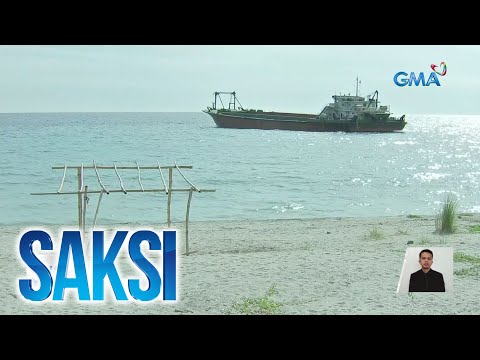
According to a report by Ian Cruz in “24 Oras”, MT Hyperline 988 is registered under Sierra Leone, but a Philippine flag can be seen waving on top of it.
The Philippine Coast Guard (PCG) was not able to immediately detect the vessel because its automatic identification system was turned off.
The PCG personnel also tried communicating with the crew via radio on Wednesday afternoon, but there was no response.
"The Coast Guard K9 unit also conducted a paneling inspection with a narcotic detection dog and yielded a negative result," the PCG said in a statement posted in its social media account.
The PCG said the Chinese crew members departed from Hong Kong on May 11.
However, the Chinese nationals failed to present original and printed versions of relevant documents, including the crew list, passports, and seaman's books.
The vessel’s supposed destination was at the Manila Anchorage Area, but the crew decided to go to Zambales instead due to the high anchorage fee in the country’s capital. However, the town of San Felipe has no pier where they can pay the fee.
According to the ship’s captain, a Filipino company bought the vessel that’s why they are in the country.
The PCG has detained the vessel due to the absence of a Notice of Arrival in the local Coast Guard and 21 deficiencies. Investigation is ongoing.
San Felipe is 130 nautical miles away from Bajo de Masinloc or the Panatag Shoal in the West Philippine Sea.
The PCG said Bureau of Immigration personnel have visited the vessel.
Moreover, staff from the Zambales Provincial Environment and Natural Resources Office also went to San Felipe to check the presence of an alleged dredging vessel despite the suspension of dredging activities since March. — Vince Angelo Ferreras/BAP, GMA Integrated News
3千トン級バルク船(DEYI号):IMO8360676は韓国と中国の航海ではAIS:船舶自動識別装置の電源を入れているが、ロシアへの航海では記録が残らなように電源をオフにしているようだ。日本に来たことがあるのかは不明。ただ、 トーゴ籍船に問題がある船が含まれていると考えて間違いなないと思える。
トーゴ籍船に問題がある船が含まれていると考えて間違いなないと思える。
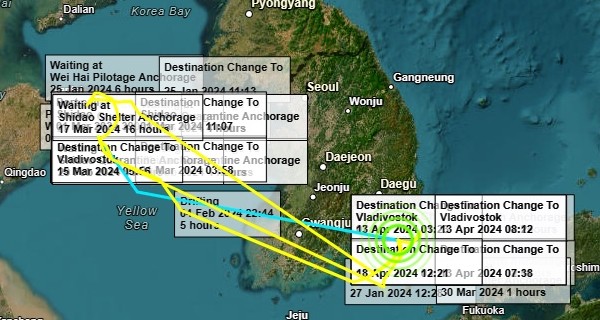
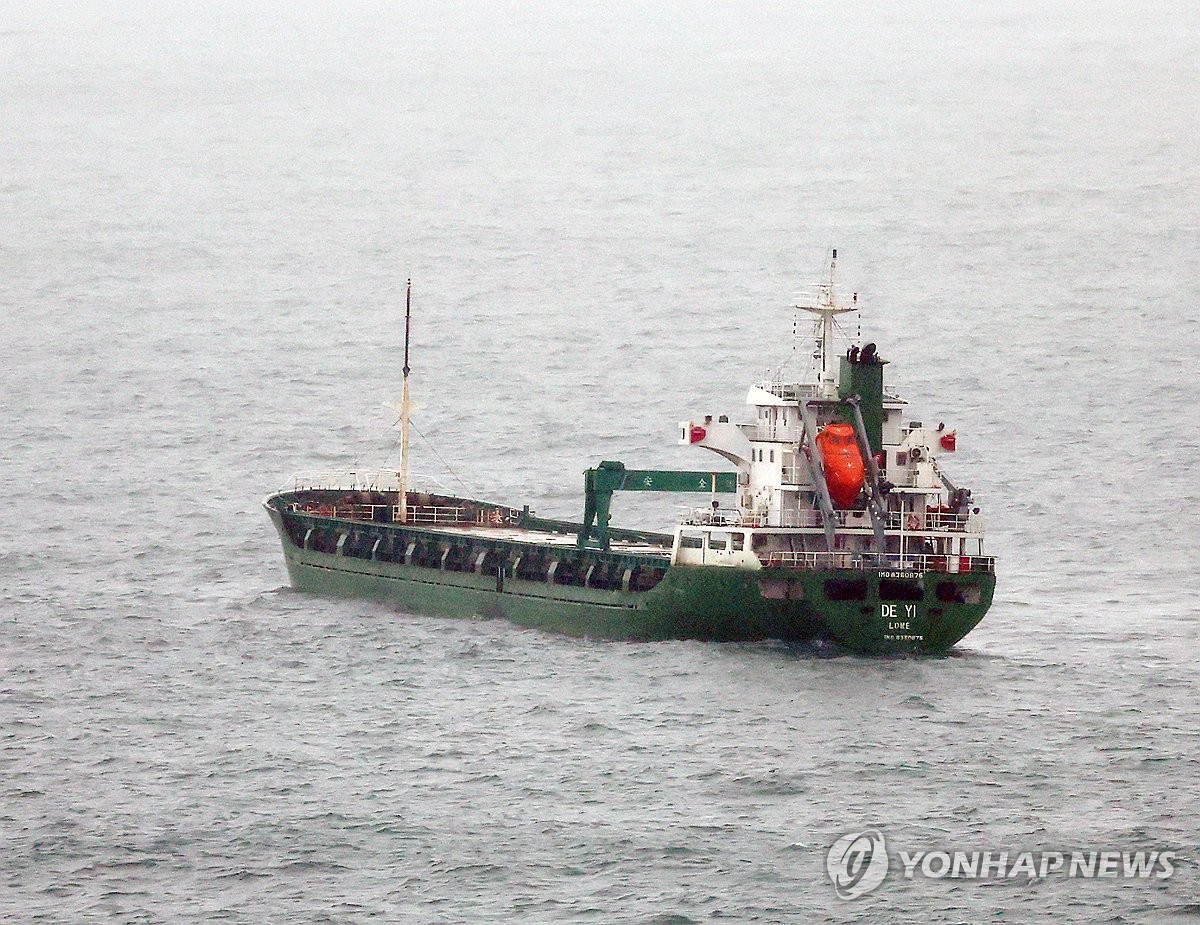
韓国当局が対北朝鮮制裁違反への関与が疑われる無国籍船を拿捕したことが分かった=3日、釜山(聯合ニュース)
停船命令に応じなかったため、海洋警察が船内に入って釜山南港に移動させたという。船舶には当時、中国人の船長と中国人やインドネシア人の船員13人が乗っていた。
この船舶がどのような違反行為に関与したのかは明らかにされていない。船舶側が貨物室の開放を拒否しており、当局は船内の貨物を確認できていないという。
2017年に採択された安保理の「制裁決議2397」は、国連加盟国が禁止行為に関与した疑いのある船舶を自国の領海上で拿捕、検査、抑留することができると定めている。
South Korea’s Foreign Ministry confirmed media reports that it took the unusual step of detaining a cargo ship that was underway near the port of Yeosu, transiting the waters between Korea and Japan. The move comes as the Seoul government has taken increased unilateral steps against North Korea including sanctioning ships involved in the weapons trade with Russia and reportedly increasing monitoring of North Korea for sanctions violations.
The official statement said that the government was conducting an investigation based on cooperation with the United States into allegations of sanctions violations by the somewhat mysterious general cargo ship named De Yi.
According to a spokesperson for the Foreign Ministry, the vessel initially refused to stop when ordered to by the South Korean Coast Guard. They were later able to redirect the ship into the anchorage at Busan on March 30, but reports are that the crew continues to refuse to cooperate. So far, they have refused to open the ship’s cargo hatches for inspection.
Reports are calling the vessel stateless with international databases also listing the flag and ownership as unknown. Built in 2006, the 6,749 dwt vessel’s last known owner and operator was in Hong Kong. Since being built, the ship was registered in China, but it appears to have been sold in 2022. It was renamed and in 2023 was reflecting registry in Togo.
The Foreign Ministry reports the ship was believed to have been in North Korea’s Namo Port before proceeding to Shandong, China, and at the time it was detained it was reporting Vladivostok, Russia as its destination. The report said there are 13 crewmembers, including a Chinese captain and Chinese and Indonesian crewmembers aboard. They are also refusing to cooperate with the South Korean authorities.
While South Korea has detained ships in port, an action against a merchant ship underway is very rare. The media reports suggest that the South Koreans were acting on information supplied by the United States.
政府当局が拿捕して抑留中の3千トン級バルク船(DEYI号)が、2月には北朝鮮で貨物を積んだ後、中国に運搬したことが分かった。韓国政府は、北朝鮮の南浦(ナムポ)港で無煙炭を積んだ後、ロシアに向かっていたこの船舶を米国の要請を受けて先月末に拿捕した。これに先立ち、この船舶が中国にも北朝鮮の石炭などを輸出したことが今回確認された。国連安全保障理事会の対北朝鮮制裁決議は、北朝鮮の石炭輸出などを厳しく制限している。
4日の東亜(トンア)日報の取材を総合すると、韓米当局は、DEYI号が政府に摘発される約1ヵ月前の2月に船舶自動識別装置(AIS)をオフにして北朝鮮付近で貨物を積み込み、これを中国で荷揚げしたと見ている。政府消息筋は、「この船舶が対北朝鮮制裁を違反したと韓米が判断した主な状況」と明らかにした。この船舶は、南浦港など北朝鮮の港に入港したり、近隣の海上で積み替える方式で石炭などを運んだとみられる。最近、北朝鮮と中国の近海では、違法な積み替え活動と疑われる船舶が多数出現したという。
DEYI号が今年1月に中国山東省の威海港を出港し、釜山(プサン)港に入港したことも確認された。DEYI号は当時、韓国港湾当局に目的地をウラジオストクと届けたが、釜山港を出港した後、AISをオフにして姿をくらました。これを含め、この船舶がAISをオンにして公開運航記録を残したのはこの1年間で2件にすぎない。そのため、韓米当局はDEYI号がAISをオフにして長期間、対北朝鮮制裁違反活動を続けてきたと推定している。
DEYI号は香港所在の会社が所有する船舶と把握された。「アジア太平洋地域港湾局統制委員会安全検査資料」などによると、この船舶は「香港ウィリム海運有限公司」が所有主と表記されている。ただし、2022年2月に設立された同社は、香港市内のショッピングセンターの建物に住所を登記している。業種や電話番号などは一切公表していない。
DEYI号は06年2月から22年8月まで約16年、中国国旗を掲げて航海していたが、昨年5月からトーゴ国旗に変えて運航していたことが分かった。現在はトーゴ国旗の期限も切れて無国籍だ。
船社が香港にあるにもかかわらず、このように国旗を別の場所に変えたのは、「便宜置籍(船舶を自国ではなく第3国に登録する)」制度を活用するためとみられる。船舶に対する管轄・管理の責任は、船舶が掲げている旗、つまり旗国にあるという原則がある。そのため、旗を変えれば、公海上で問題が発生しても、この原則のために国際社会の積極的な制裁が難しくなる可能性がある。一部ではこれをめぐって、「国連安保理の対北朝鮮制裁を回避することが狙い」という批判もある。
北朝鮮が違法な石炭輸出のために香港に幽霊会社を設立し、船舶を運航した可能性も否定できない。18年に国連の対北朝鮮制裁対象に指定された北朝鮮の船舶「長安号」も、香港に設立された「長安海運技術有限公司」の所有だった。
申圭鎭
South Korea’s Foreign Ministry has confirmed media reports that it had detained a cargo ship that was underway near the port of Yeosu, transiting the waters between South Korea and Japan.
The Ministry said that the government was conducting an investigation based on cooperation with the US into allegations of sanctions violations by a general cargo ship named De Yi (IMO 8360676).
The vessel was asserted to have refused to stop when so ordered by the South Korean Coast Guard. The vessel was then redirected to Busan anchorage, where it arrived on March 30th. However, there are reports that the crew continued to refuse to cooperate, refusing so far to open the ship’s cargo hatches for inspection.
South Korea recently has taken an increased number of unilateral steps against North Korea. These have included sanctioning ships involved in the weapons trade with Russia and reportedly increasing monitoring of North Korea for sanctions violations.
Reports are calling the vessel stateless with international databases also listing the flag and ownership as unknown. Built in 2006, the vessel’s last known owner and operator was registered in Hong Kong. Since being built, the ship was registered in China, but it appears to have been sold in 2022. What looks to be a prime example of a “shadow fleet” vessel was renamed and in 2023 was registered as Togo-flagged, although that might no longer be operative.
South Korea said that the ship was believed to have been in North Korea’s Namo Port before proceeding to Shandong, China. At the time it was detained it was reporting Vladivostok, Russia as its destination. The report said there are 13 crewmembers, including a Chinese captain and Chinese and Indonesian crewmembers aboard.
Actions such as this against merchant ships that are underway are very rare. Such detentions as do take place tend to be when the vessel is in a port.
2006-built, 2,999 gt De Yi is reported as having a Hong Kong-addressed owner and manager. Marine Traffic has it as Togo-flagged. As of April 4th it was Stopped at Busan Anchorage.
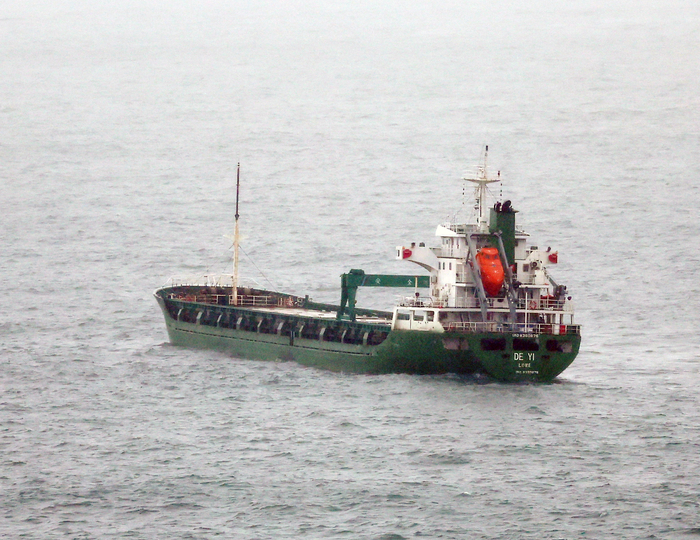
3日、釜山甘川(プサン·カムチョン)港近くの墓薄地に北朝鮮制裁違反行為に関与した疑いが持たれている船舶(3000トン級·乗組員13人)が停泊している。 聯合ニュース
3日、外交部などによると、先月30日頃、全羅南道麗水付近の海上で制裁違反行為に関与した疑いが持たれている3000トン級の貨物船を拿捕した。
同船は「ザ·イー(DEYI)」号で先月末、北朝鮮の南浦(ナムポ)港を出発し、中国山東省の須島(スダオ)を経てロシアのウラジオストクに向かう途中、韓国領海を通過して拿捕された。
海洋警察は、該当船舶を釜山南港に移動させたという。 当時、船舶には中国人船長と中国とインドネシア国籍の船員など13人が搭乗していたという。
該当船舶がどのような対北朝鮮制裁違反行為に関与したのかは明らかにされていない。 現在、船長が貨物窓の開放を拒否し、調査に応じないため、調査関係者らが内部貨物を具体的に確認できずにいるという。
ただ、以前にも北朝鮮がトーゴなどで船舶の国籍を偽装して石炭、精製油などを運送した事例があり、今回も類似の事例であると見て調査が進められている。 2019年、政府はトーゴ国籍の「タレントエース」号が北漢山石炭を運搬した疑惑で拿捕し抑留した。
今回の拿捕は、米国が該当船舶の制裁違反行為への関与が疑われるという情況情報を韓国政府に提供したことで行われたという。
外交部当局者は「該当船舶の安保理対北朝鮮制裁決議違反の疑いと関連して韓米間の緊密な共助を土台に調査を実施している」と明らかにした。
2017年に採択された安保理対北朝鮮制裁決議2397号は、国連加盟国が対北朝鮮制裁上禁止行為に関与した疑いのある船舶を自国の領海上で拿捕·検索·抑留することができると規定している。

韓国当局が対北朝鮮制裁違反への関与が疑われる無国籍船を拿捕したことが分かった=3日、釜山(聯合ニュース)
安保消息筋によると、当局は先月30日ごろ、南西部の全羅南道・麗水付近の海上で制裁違反行為に関与した疑いのある3000トン級の貨物船を拿捕した。
停船命令に応じなかったため、海洋警察が船内に入って釜山南港に移動させたという。船舶には当時、中国人の船長と中国人やインドネシア人の船員13人が乗っていた。
この船舶がどのような違反行為に関与したのかは明らかにされていない。船舶側が貨物室の開放を拒否しており、当局は船内の貨物を確認できていないという。
2017年に採択された安保理の「制裁決議2397」は、国連加盟国が禁止行為に関与した疑いのある船舶を自国の領海上で拿捕、検査、抑留することができると定めている。
By Marianna Parraga and Jonathan Saul
When the supertanker Young Yong sailed to the Chinese port of Qingdao in September last year, it had quality certificates for its cargo stating it was transporting Malaysian crude oil, according to the documents reviewed by Reuters.
But satellite images and photos show the Chinese-owned ship had loaded the oil four months earlier in Venezuela, an OPEC nation in South America under U.S. oil sanctions.
The Young Yong is one of three vessels identified by Reuters that were chartered by little-known companies to export Venezuelan oil and used false documents to conceal its origin, according to shipping documents and 11 sources with knowledge of the trade.
Two of those tankers, including the Young Yong, were designated this month by U.S. authorities for violating sanctions on Iran, one of Venezuela's closest allies.
Six shipping and oil trading specialists told Reuters the use of false documents to conceal cargoes originating in sanctioned countries including Venezuela and Iran has increased compliance risks for oil and trading companies, amid a proliferation of international sanctions.
"It's now becoming clear you cannot trust certificates of origin even when they come with official government documentation," said Cari Stinebower, a U.S.-based partner with law firm Winston & Strawn, who advises oil and trading companies how to comply with sanctions.
The Young Yong was one of several tankers named by the U.S. Treasury on Nov. 3 as part of a "smuggling network" that has used forged documentation to ship Iranian oil to finance Iran's Revolutionary Guards and Hezbollah. The Treasury designated the tanker as a frozen asset and placed its owner, Marshall Islands-registered Technology Bright, under sanctions.
The U.S. Treasury declined to comment on the involvement of the Young Yong or the other vessels identified by Reuters in shipping Venezuelan crude.
Stinebower, who previously worked as a legal counsel for the U.S. Treasury's sanctions enforcement arm OFAC, said the use of false documents to conceal the origin of cargoes was pioneered by Iran to avoid U.S. sanctions. Citing cases she has worked on as a commercial lawyer, Stinebower said it appeared the technique was now being adopted to transport Venezuelan oil but she declined to provide further details.
Venezuela's oil ministry and state-owned oil company PDVSA did not respond to requests for comment. Iran's mission to the United Nations in New York also did not respond to Reuters questions.
PDVSA documents reviewed by Reuters said a vessel named the Comuna loaded 1.98 million barrels of oil in the Venezuelan port of Jose from May 11 to 21 last year.
However, independent monitoring company TankerTrackers.com, which specializes in analyzing vessel movements for insurance and shipowners' research, used satellite images and photos to identify the tanker as the Young Yong.
The images show the vessel's name had been painted over but the tanker is identifiable because of the distinctive white arches flanking its bridge, the position of the cranes on its deck and the shape of its funnel, said Samir Madani, TankerTrackers.com's owner.
When the Young Yong set sail from Venezuela after loading the oil, its location transmitter showed it departing from the West African port of Lome.
The Young Yong then stopped near Malaysia between early July and August 2021. While there, on July 8, it obtained a quality certificate from Singapore-based laboratory Saybolt that identified its cargo as Malaysian heavy crude – which has similar characteristics to Venezuela's Merey 16 crude grade. The certificate measures aspects of oil - such as its density and its levels of sulfur and metals - that allow a buyer to be sure a cargo is within a contract's specifications.
Saybolt's U.S. owner, Core Laboratories N.V. CLB.N, said in a statement to Reuters that it had certified the crude as Malaysian heavy oil blend based on documentation it received from the client and its analysis of the quality of the oil. The company said it had no reason to doubt this was the case. It did not identify who the client was.
The quality certificate was shared with Reuters by advocacy group United Against Nuclear Iran (UANI), which tracks shipments potentially violating sanctions.
Shipping database Equasis listed contact details for the Young Yong's owner Technology Bright as care of Hong Kong-based East Wind Ship Management. A Reuters reporter could not find East Wind Ship Management at the address listed in the database nor find a contact elsewhere to seek comment. Reuters was unable to identify the buyer of the oil in China.
Indonesian authorities said in early November that the Young Yong had run aground off the Riau Islands on Oct. 26. UANI said it was carrying Venezuelan fuel oil when it ran aground and was likely trying to reach Nipah, a popular ship-to-ship transfer hub near Indonesian waters, according to satellite pictures and vessel tracking, analyzed by the advocacy group.
Unsuccessful sanctions
Christian M. Ingerslev, chief executive of Maersk Tankers, said the proliferation of sanctions had led to "separate fleets and separate markets run in parallel": some vessels were operating off-the-radar to service sanctioned countries, sometimes without proper insurance, he said.
London-headquartered ship broker Braemar PLC BRMS.L estimated that the total fleet servicing Iran and Venezuela, despite U.S. sanctions, consists of more than two hundred tankers, including some 82 supertankers like the Young Yong that can carry up to two million barrels of oil each.
The United States imposed oil trading sanctions on Venezuela in 2019 after calling Maduro's re-election the previous year a sham. Washington has maintained pressure on the socialist leader to hold fair elections and release political prisoners: it said last week it could relax sanctions if there is progress in talks between Maduro's government and the opposition.
The use of a wide array of tactics - including false documentation, fake vessel names and ship-to-ship transfers of cargoes at sea - has enabled Venezuela to export more than 360 million barrels of crude and fuel since the imposition of U.S. sanctions, according to Reuters calculations based on PDVSA's internal documents and ship tracking data.
That represents more than two-thirds of Venezuela's total oil exports from 2019 through October 2022. The remainder went either directly to its ally Cuba or to other destinations in the Caribbean and Europe under exemptions to U.S. sanctions, according to the Reuters calculations.
PDVSA did not respond to a request for comment on those figures.
When asked about Reuters' findings about the use of false documentation by vessels carrying Venezuelan crude, a U.S. State Department spokesperson said: "our Venezuela sanctions remain in effect".
PDVSA documents from May 2021 listed Yunshu Maritime Ltd as the charterer of the Comuna – the name used by the Young Yong to load Venezuela crude that month. The PDVSA shipping documents and invoices for the cargo dated September 2021 did not provide contact details for Yunshu Maritime. Reuters was unable to find a website or address for the company.
Yunshu Maritime was also the charterer for another supertanker that loaded Venezuelan oil in May 2021 under the name Joy, PDVSA's loading schedules showed. Using satellite images and photos, TankerTrackers.com identified that vessel as the Panamanian-flagged tanker Adisa, which was also blacklisted this month by the U.S. Treasury for transporting Iranian oil.
The Treasury said the vessel is controlled by a company owned by Viktor Artemov, a Ukrainian national who oversees a network of cover companies used to sell sanctioned Iranian oil and channel the proceeds to the Revolutionary Guards and Hezbollah.
Artemov, who has been placed under U.S. sanctions, did not respond to requests for comment.
The Treasury named the Adisa's owner as Triton Navigation Corp, which is listed on Equasis as care of Thomarose Global Ventures. Reuters was unable to locate Nigeria-based Thomarose Global Ventures for comment.
The Adisa set its location signal to make it appear that it set sail from Africa in early June 2021 with Malaysia as its destination. The vessel made a stop in Malaysia between July and early September and then switched its transponder off for about a week before reappearing near Qingdao in mid-September, where it discharged, according to ship tracking data.
However, a bill of lading for the Adisa dated June 3, 2021 and issued by West Atlantic Port Services in Togo said the vessel had loaded 1.89 million barrels of West African blended heavy crude oil, according to the document reviewed by Reuters. West Atlantic Port Services did not answer phone calls for comment.
(Reuters - Additional reporting by Daphne Psaledakis and Matt Spetalnick and Michelle Nichols; Editing by Daniel Flynn)
Uei Maru (ex-Oei Maru). IMO 8810334. Length 70 m, 757 t. Mongolian flag. Unknown classification
society. Built in 1988 in Saiki (Japan) by Miura. Owned since November 2020 by Forward Marine Ltd
(Hong Kong, China).
She was reportedly scrapped in Ningde (China) in September 2016 but actually escaped the
blowtorches. Her Automatic Identification system has been switched off since February 2017. Though,
she has kept on sailing, flying the flag of Belize then of Sierra Leone and performing undisclosed traffics.
Since November 2020, she has been inspected eight times in the Vietnamese port of Quangninh. The 28
reported deficiencies did not lead to any detention. In September 2022, Hong Kong (China) inspectors
reported 15 deficiencies. Six were related to fire safety, emergency systems, safety of navigation and to
maintenance of the ship and equipment and were considered as grounds for detention. The Uei Maru
was finally beached in Chattogram flying the flag of Mongolia on October 13, 2022.
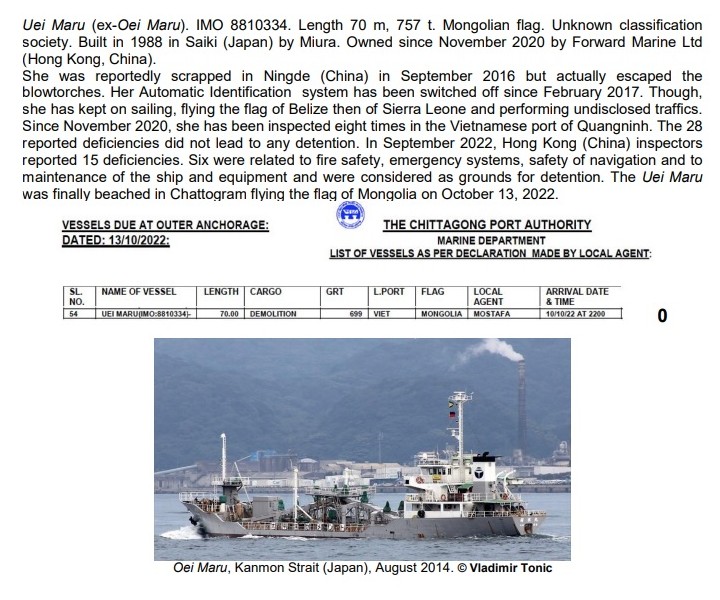
by The Editorial Team
Vessel identity laundering operations jeopardize the integrity of the IMO ship registration system, which the world relies upon in order to identify, track, and interact with the 60,000 ships, finds a new report.
According to C4ADS, vessel identity laundering is a novel tactic in which one or more vessels adopt a different identity on Automatic Identification System (AIS) transmissions in order to allow “dirty” ships to assume “clean” identities, and involves at least one vessel in this operation assuming an identity that is obtained by defrauding the IMO.
Vessel identity laundering is significantly more sophisticated than previously observed instances of “vessel identity tampering,” in which vessels modify their physical appearance or broadcast false data on AIS transmissions. Given its complexity, vessel identity laundering presents unprecedented challenges for maritime regulators and risks undermining global shipping practicesIn recent years, C4ADS has observed at least 11 ships engaging in elaborate schemes to create fraudulent ship registrations with the IMO, which are subsequently used to “launder” the identity of vessels that have been associated with illicit activities. In particular, we have seen networks involved in DPRK sanctions evasion and smuggling use these tactics to avoid the heightened scrutiny of the sanctions regime.
This issue brief seeks to empower law enforcement and civil regulators to detect and disrupt vessel identity laundering operations by explaining how vessel identity laundering operations work and demonstrating how they can be detected using AIS data, satellite imagery, IMO registration records, and other sources of publicly available information.
The KINGSWAY, sanctioned by the UN Security Council (UNSC) for engaging in a ship-to-ship transfer with a North Korean tanker, laundered its identity into the APEX/SHUN FA in late 2018.
- The SUBBLIC, recommended for designation by the UN Panel of Experts for numerous deliveries of fuel to North Korea, laundered its identity into the HAI ZHOU 168 in mid-2019.
- In light of this report’s findings, the authors suggest the following recommendations for the maritime community and its regulators.
- The IMO should require resubmission of vessel photographs and current details from operators at regular intervals for ships to maintain their registration, and deregister noncompliant vessels.
- The IMO should publish a list of IMO numbers that are cancelled and vessels whose registrations are rescinded.
- The IMO’s Maritime Safety Committee should coordinate a working group of representatives from government, industry, and civil society organizations to strengthen risk screening procedures for the IMO number application process.
- The IMO’s Maritime Safety Committee should promote transparency of the IMO number system by publishing annual reports that outline the measures taken to combat IMO number fraud, statistics on registration trends, case studies, and other guidance on evasion typologies. Digital Identity
- The IMO’s Maritime Safety Committee should coordinate a working group of representatives from government, industry, and civil society organizations to develop hardware and software security standards for preventing the tampering of AIS transponders. This working group should produce a list of AIS transponder models that meet anti-tampering standards for both Class A and Class B transponders. The transponder model’s certification should be reviewed regularly. Flag registries and other maritime authorities should implement tools and methods to detect AIS tampering or anomalies by ships under their jurisdiction, and information on detected cases should be published and shared with other maritime regulators.
Physical Identity
All maritime regulators and enforcement agencies should detain and investigate ships that have painted over their original IMO number and marked a different one, as well as any other entities responsible for facilitating identity tampering.
Data Sharing
The IMO should mandate the expansion of ship information provided in GISIS to include the following data points:
- Vessel specifications (e.g. length, breadth, gross tonnage, deadweight tonnage);
- Historical MMSI numbers and call signs, complete with periods of use;
- Photographs submitted to the IMO.
In addition:
- The IMO should mandate the GISIS to distinguish whether a vessel’s flag registration is provisional or permanent. If a vessel’s flag registration is provisional, GISIS should indicate the date of issue and expiry. GISIS should prominently mark the vessels whose provisional flag registration status has expired.
- The IMO should create a secure communication channel where the public and whistleblowers can submit information on vessels, individuals, companies, and officials that are abusing or facilitating the abuse of the IMO number system.
- The UN Panel of Experts on the DPRK should include in its midterm and final reports a table of fraudulent IMO-registered and AIS identities used by vessels linked to DPRK sanctions evasion activities.
- Governments should regularly publish circulars and advisories that include lists of fraudulent IMO-registered and AIS identities used by DPRK-linked vessels. Governments should ensure that these blacklists are disseminated to authorities responsible for maritime security.
SEOUL--Smugglers suspected of evading sanctions on North Korea have turned to schemes to create fraudulent identities for sanctioned ships, a U.S.-based research group said in a report released on Thursday.
Ships suspected of smuggling have long modified their physical appearance or broadcast false position data, said the report from C4ADS, a non-profit group.
But the practice of “vessel identity laundering” is significantly more sophisticated and not only undermines sanctions but jeopardizes the integrity of the International Maritime Organization (IMO) ship registration system, it added.
“Given its complexity, vessel identity laundering presents unprecedented challenges for maritime regulators and risks undermining global shipping practices,” the report said.
When asked about the report, a spokesperson for the IMO, the United Nations’ shipping agency, said any specific unlawful practices should be brought to the organization so they could be addressed.
“IMO has been working to address issues related to fraudulent registration and related unlawful practices including the registration of vessels without the knowledge or approval of the relevant national maritime administration,” the spokesperson added. “This work is ongoing.”
North Korea is under strict international sanctions imposed over its nuclear weapons and ballistic missile programs. Talks aimed at persuading Pyongyang to give up those weapons in return for lifting sanctions have been stalled.
Independent sanctions monitors have reported to the United Nations that North Korea has continued to evade sanctions, albeit at a lower level since the country imposed its own border lockdowns to prevent a coronavirus outbreak since last year.
“The international shipping order has operated on the basis that an IMO number is an authoritative and unique identifier issued to one ship--a real ship, if that has ever needed to be spelled out,” C4ADS said.
But the group’s case studies of two ships allegedly involved in evading North Korea sanctions show how the IMO registration process can be hijacked to issue a registered identity to a non-existent vessel, which in turn can be used to disguise the identity of other ships, the report said.
C4ADS, which says it provides data-driven analysis and reporting on global conflict and security issues, said overall it had observed at least 11 ships engaging in elaborate schemes to create fraudulent ship registrations in recent years.
The C4ADS report outlined ways that law enforcement and civil regulators might detect and disrupt the activities of such vessels using tracking data, satellite imagery, IMO registration records, and other sources of publicly available information.
【ニューヨーク=上塚真由】国連安全保障理事会で北朝鮮制裁決議の履行状況を監視する専門家パネルの調査で、北朝鮮が外貨稼ぎのため、昨年1~11月に少なくとも15隻の中国漁船に対し、漁業権を売却していたことが判明した。国連外交筋が明らかにした。専門家パネルは、北朝鮮による制裁破りの新たな手口として警戒を呼びかけている。
専門家パネルは過去1年間の制裁の履行状況の報告書を近くまとめ、公表する予定だ。
国連外交筋によると、北朝鮮の漁業免許を所持する中国漁船は、日本海や東シナ海などで確認された。漁業関係者の証言では、北朝鮮近海で約200隻の中国漁船が操業し、免許は月5万元(約81万円)で売られているという。中国漁船が北朝鮮の国旗を掲げて偽装工作を行っている実態も確認された。漁業権の販売・移転は2017年12月に採択された安保理決議で禁止されている。
海上で違法に石油精製品などの積み荷を移し替える「瀬取り」についても、船体を偽装するなど手口を巧妙化させて継続していると指摘。専門家パネルの調査では昨年2月以降、少なくとも50隻の船舶と160の企業が関与したことが分かったという。
また、韓国による制裁違反も新たに判明。北朝鮮・開城に昨年開設された南北共同連絡事務所で使う石油精製品を国連安保理に届けずに北朝鮮に持ち込んでいた。韓国側は専門家パネルの調査に対し、約340トンを運び込み、使用しなかった約4トンだけを持ち帰ったことを認めたという。安保理決議では北朝鮮への石油精製品移転を報告するよう加盟国に義務付けている。
専門家パネルは、北朝鮮は核・ミサイル開発計画を継続していると分析した。衛星画像から、北朝鮮の寧(ニョン)辺(ビョン)の核施設で昨年2~11月に新たな施設や水路の建設が確認され、同6月中旬には稼働していることを示す排水作業も行われたとしている。
国連安全保障理事会の経済制裁下で外貨獲得に苦しむ北朝鮮にとって、中国漁船への漁業権売却が貴重な外貨獲得源となっていることが、対北朝鮮制裁決議の履行を監視する北朝鮮制裁委員会の専門家パネルの年次報告書で明らかになった。中朝国境地帯の中国側の複数の漁業関係者は読売新聞の取材に、漁業権売却が制裁対象と明記された2017年12月以降も売買は横行していると証言した。
◆「証拠残さない」
1月下旬、丹東近郊を訪れると、中国と北朝鮮の間を流れる鴨緑江河口付近の港に、中国と北朝鮮の双方の国旗を掲げた漁船2隻が係留されていた。地元住民によると、いずれも渤海や黄海といった近海で操業する漁船で、海が荒れる真冬は漁に出ていないという。
2隻が漁業権を北朝鮮から購入した船かどうかは不明だが、漁業権売買に詳しい関係者によると、北朝鮮の漁業権を購入した中国漁船は、北朝鮮漁船を装うため北朝鮮国旗を掲げるのが一般的という。
この関係者によると、北朝鮮側が売買を持ちかけるのは主に、北朝鮮東部・元山(ウォンサン)沖の日本海でのイカ漁と、西側の黄海での近海漁業の権利だ。北朝鮮側が中国の仲介業者に提示する漁業権売却の値段は、日本海側であれば6~11月の1漁期当たり1隻約5万ドル(約545万円)、黄海は1か月当たり1隻約5000ドル(約54万5000円)が相場という。17年12月に国連安保理の追加制裁決議で漁業権売買が明確に禁止される前は正式な契約書も交わされていたが、昨年からは「証拠を残さないよう口頭での取引になった」という。
特に日本海のイカ漁は、中国の禁漁期とも重なる6~9月が最盛期とされ、昨年も、北朝鮮と国境を接する遼寧省のほか、福建省や浙江省、山東省からも、多くの船が仲介業者を通して漁業権を買って漁に出たという。
丹東はその漁業権取引の主要な舞台だ。北朝鮮当局の水産部門担当者が丹東を訪れ、仲介業者と漁業権売却のやりとりをする。仲介業者から北朝鮮側への支払いは、中国当局の監視を避けるため、両替が必要な米ドルを使わず、主に人民元でなされるという。
◆イカを乱獲
漁業権を購入した中国漁船が北朝鮮周辺海域で操業する際、北朝鮮漁船は自国海域から追い出されているとの見方が強い。日本政府関係者は「追い出された北朝鮮漁船が、より沖合の日本の排他的経済水域(EEZ)内にまで出て違法操業をするようになった」と指摘する。日本海の能登半島沖の好漁場「大和(やまと)堆(たい)」周辺では17年以降、大量の北朝鮮漁船が押し寄せてイカを乱獲し、すでに深刻な問題となっている。
Fraudulent ship registration makes the already challenge task of sanctions enforcement more difficult.
By Olivia Vassalotti and Cameron Trainer
09/26/18(The Diplomat)
On February 24, 2018, a patrol aircraft of the Japan Maritime Self-Defense Force found a North Korea-flagged vessel, the Chon Ma San, engaged in what appeared to be a ship-to-ship transfer with another vessel. Such transfers are prohibited under United Nations sanctions on North Korea. Japan’s Ministry of Foreign Affairs published a notice on its website identifying the other vessel as a Maldives-registered tanker, the Xin Yuan 18. There was just one issue: the vessel was never registered by the Maldives.
The identity falsification perpetrated by the Xin Yuan 18 is far from an isolated case. On the contrary, the problem is surprisingly widespread and vastly undertreated. It circumvents the process by which countries regulate the use of their flag for international trade. Some countries allow foreign-owned or controlled vessels to use their flag through an open registry. Others may choose to only register vessels with ties to the country through ownership or crewing. This is termed a closed registry. Still others just choose not to allow the use of their flag for international trade at all. All can be affected by vessel identity falsification.
This falsification can take different forms, from a vessel continuing to claim a country’s flag after being struck from its flag registry, to manipulating the information a ship transmits to broadcast incorrect information, to an unusual and highly concerning phenomenon: the creation of fraudulent national flag registries. Though a range of actors looking to mask illicit trade may exploit these approaches to hide their activity, North Korea is actively making use of all three.
Enjoying this article? Click here to subscribe for full access. Just $5 a month.
The first variant is simple for a vessel’s owners and managers to perpetrate. A vessel, after its registration with a country is either terminated or expired, simply continues to use the identification it was once legitimately issued. After Cambodian authorities decided to close their registry, which had been used by North Korean-controlled vessels looking to evade UN sanctions, some of those vessels continued — in violation of national law — to fly the Cambodian flag.
The second method, broadcasting a falsified identity, is also relatively straightforward. All vessels over 300 gross tons are required to have an Automatic Identification System (AIS) transmitting information about their course and identity, including name, flag, and call sign. Vessels engaged in illicit activity often alter these transmissions to reflect either entirely fictional identity information or that of another vessel. All a ship operator needs to do is manually input false information into the ship’s AIS transponder.
One example of this practice is the O Ka San, a vessel listed by the International Maritime Organization (IMO) as being previously flagged to North Korea, but now having an “unknown” country of registration. The ship’s most recent AIS transmission on July 6, 2017, captured by ship-tracking platform MarineTraffic, identified the vessel as the Sarisa, a container ship flagged to Tanzania. According to the official IMO database, the vessel was never known by that name, nor was it ever registered in Tanzania. In fact, no ship named Sarisa exists in the IMO database. The vessel likely altered its AIS transmissions to avoid restrictions on North Korea and its vessels.
The third type of identity falsification – the issuance of fraudulent registration documents to the IMO without the knowledge of the country in question – is significantly more complex and represents a major maritime governance challenge.
In the case of the Xin Yuan 18 described above, for instance, the Maldives Defense Intelligence Service alleges that a Maldives national communicated with the IMO using a Gmail account fraudulently created in the name of a former employee of the Maldives Transport Authority, the body responsible for registering vessels. Using this email, he provided the IMO with fraudulent registration documents for the ship, which appropriated the call sign of a legally registered Maldivian fishing vessel. These documents appear to have been accepted as proof of registration by the IMO, despite not resembling those normally used by the Maldives.
In other cases, companies have posed as national shipping registries, leading to hundreds of vessels claiming the country’s flag without its knowledge or authorization. The Democratic Republic of Congo, Fiji, Micronesia, Nauru, and Samoa have all fallen victim to this kind of fraud despite not authorizing the use of their flag for international trade. In all of these cases, at least one company was created for the sole purpose of operating a fraudulent registry, and the effort was facilitated by authentic-looking websites which at first — and even second — glance appeared to be perfectly legitimate.
Perhaps the most startling is the case of Micronesia. Over 300 vessels may have flown the country’s flag. This was made possible by the IMO erroneously recognizing the fraudulent registry as an official Micronesian entity. In addition, Fiji is investigating 91 reported cases of vessels claiming its flag without authorization, at least 20 of which were linked to North Korea.
It is unclear what proportion of vessel owners were aware of the fraudulent nature of the registrations, but it seems plausible that at least some were unsuspecting victims.
Vessel identity falsification, in whatever form it takes, represents a global maritime safety, security and governance challenge. Fraudulent registries of the kind set up for Micronesia deny that country the revenue associated with operating a registry, while affiliating potentially suspect vessels with the country without their knowledge. They can also serve as a method for vessels to engage in a form of “reputation laundering,” by allowing ships to mask a history of illicit activity before migrating to a legitimate or more reputable registry. Case in point, the Lian De was deregistered by Tanzania in July 2016 for its links to North Korea, then fraudulently registered under the Fijian flag, and subsequently registered to Panama – the world’s largest open registry – in March 2017.
Fraudulent registrations may also hinder the processes for dealing with a maritime emergency. For example, in January of last year the cargo vessel Tong Da ran aground in Japan while claiming the Fijian flag. In scenarios like this, the vessel’s flag state is generally responsible for rectifying the situation. In this case, however, Fijian authorities reported no record of the vessel when queried by the Japanese, and the vessel appears to have been salvaged without Fijian participation. Similar issues could arise in the case of interdictions of vessels in international waters, which normally require the consent of the vessel’s flag country. It is unclear how this consent would be acquired for a fraudulently registered vessel or, indeed, whether such consent is even needed to interdict a vessel without valid registration.
Vessel identity falsification is a complex issue with implications for the IMO and its members, whether they operate open registries or not. It is even an issue for non-members like Micronesia, that have found themselves the victims of astonishingly brazen acts of fraud. The IMO appears to have finally recognized this, and recently added the subject to the agenda of its Legal Committee. In the readout from that meeting, the IMO claims to have circulated information “[…] to ensure that port State control officers were also informed and would take appropriate action against ships fraudulently flying a flag.” Despite this, it does not appear that much progress has been made in curbing the practice of identify falsification; ships continue to be detained claiming Micronesian and Samoan registration.
While the IMO has begun taking a stand on the issue, this cannot be solved by the IMO alone. The IMO must first take steps to ensure they never again authorize fraudulent registries or accept forged documents, as highlighted in the cases above. But even more importantly, the IMO must coordinate the actions of the international maritime community and act as a leader in encouraging states to share information and act on instances of identity manipulation in their jurisdictions. Increased communication between governments, registrars, and the IMO will reduce gaps and uncertainties currently exploited by illicit actors in the maritime space. This problem will not be solved quickly, but increasing communication and due diligence in the maritime sphere will go a long way towards reducing opportunities for fraud.
Olivia Vassalotti is a researcher interested in nonproliferation, trade controls, and sanctions evasion and implementation.
Cameron Trainer is a Research Associate with the James Martin Center for Nonproliferation Studies currently focusing on sanctions policy and implementation.
【ニューヨーク國枝すみれ、バンコク西脇真一】国連安全保障理事会の北朝鮮制裁委員会の専門家パネルは2日までに、北朝鮮が昨年12月に採択された石油制裁を破り、その手口を巧妙化させていると懸念する年次報告書をまとめた。今月中にも発表する。ミャンマーなどが北朝鮮と軍事協力を続けている可能性にも注目している。
報告書は、北朝鮮のタンカーが公海上などで別の船から石油精製品や原油を積み込んでいることが確認されたとして、海上自衛隊の哨戒機が1月20日に発見した上海沖での積み込み事例にも言及。北朝鮮の国旗を消し、船名や船体の色も変えていたと指摘し「高度な偽装が行われている」と警告した。
また、北朝鮮が制裁対象の石炭輸出などで2017年に約2億ドル(約220億円)を獲得したと指摘。北朝鮮産の石炭は昨年8月に全面禁輸となったが、北朝鮮はそれ以降にも少なくとも23回、原産地を詐称して輸出した疑いがあるとしている。北朝鮮産の石炭を輸入したとされる国は、ベトナム、ロシア、中国、韓国、マレーシアなど。日本の購入は確認されていない。
さらに、北朝鮮がミャンマーに「弾道ミサイルシステムを渡した証拠がある」との情報が寄せられたと明記した。制裁対象となっている北朝鮮の「朝鮮鉱業貿易開発会社(KOMID)」がミャンマーのミサイル技術者を招請していたという。ミャンマーが昨年6月に北朝鮮の外交官をKOMIDに所属していたとして追放したことについては評価した。
ミャンマーと北朝鮮の軍事協力関係を巡っては、00年前後からミャンマー軍事政権が北朝鮮から武器や軍事物資を輸入するなど関係を緊密化したとされる。ミャンマーの民主化勢力が「北朝鮮の支援を受け核開発に着手した」と国際社会に告発したこともあったが、民政移管後の12年、当時の国防相は国際会議で「そのような(軍事協力)関係は中止した」と発言した。
報告書には、軍事情報提供の時期は明らかにしていない。ミャンマーの技術者や北朝鮮外交官の活動を調査しているとみられる。
12日(現地時間)米ワシントンの下院外交委員会公聴会。米財務省のマーシャル・ビリングズリー・テロ・金融情報担当次官補が衛星写真と地図をスライド画面で見せながら、中国とロシアが北朝鮮の石炭密輸出を支援していると批判した。
米情報当局が注目した「バイメイ8」という船は、カリブ海のセントクリストファーネイビスの国旗を付けてロシアへ向かう予定だったが、「トランスポンダー」(船の位置を知らせる無線信号機)を消して北朝鮮に入り、石炭を積載した。北朝鮮を出た後にトランスポンダーをつけたこの船はロシアのウラジオストクに一日停泊した後、中国に向かい、石炭を降ろした。
ビリングズリー次官補は「パナマ国旗を付けた『サンユニオン号』とジャマイカ国旗を付けた『グレートスピリング号」の2隻も北朝鮮からロシアに石炭を運ぶのを助けて中国に戻った。北朝鮮が船舶の正体を操作した」とし「明白な制裁回避」と主張した。共和党のテッド・ポー議員は「数年間、我々は北朝鮮の金氏一家に弄ばれた」と述べた。
北朝鮮の船舶偽装と不透明な船舶貿易ネットワークが、国際社会の制裁の中でも北朝鮮経済が持ちこたえることができた要因ということだ。
英フィナンシャルタイムズ(FT)は13日、北朝鮮国籍と疑われる数百隻の船が香港に基盤を置く幽霊海運会社により所有・運営されていて、国旗を変えたり所有権を変更する形で経済制裁を避けている報じた。シンクタンク「米国企業研究所(AEI)」の関係者は「クモの巣のような船舶貿易ネットワークが北朝鮮の貿易と通貨の均衡を維持している」と述べた。
FTは香港の会社ユニオンリンクインターナショナルが所有する「ドルフィン26号」が代表的な例だと紹介した。この会社は中国・タンザニア・パラオなどの国旗が付いた小規模な貨物船を保有している。欧州船舶情報システム(Equasis)によると、「ドルフィン26号」は過去8年間に所有主と管理人が6回、船舶名が3回変更している。付けている国旗は5年間に4回変わった。同社が管理する「オリエンタルレディー号」も2003年以降、国旗を6回変えたが、うち2回は北朝鮮だった。このようにすれば船舶の背後と活動を追跡するのが難しくなると、専門家らは指摘した。
米国安保分野研究機関C4ADSは北朝鮮関連の事業にかかわる海運会社248社のうち160社が香港に登録されていると発表した。この機関の報告書によると、これら海運会社は船舶の国旗を何度も変え、資産がない形だけの幽霊会社を設立して登録する方法で実際の所有主を隠している。同じ住所に登録された船会社もいくつか確認されたと、FTは伝えた。
米ピーターソン国際経済研究所の北朝鮮専門家マーカス・ノーランド氏は「北朝鮮の国旗を付けた老朽船舶は取り締まりのターゲットになるため北朝鮮貿易の中心から遠ざかり、東南アジアやアフリカの国旗を付けた船が増えている」と説明した。
ビリングズリー次官補は北朝鮮が制裁を避けるために船の正体を隠す欺まん的行為をするかどうか調べると明らかにした。ビリングズリー次官補は公聴会で「北朝鮮の船に保険やメンテナンスなどを提供する側も制裁のターゲットにする」と中国側に圧力を加えた。
Nicola Capuzzo
Ships and seafarers are being illegally registered under a fake international registry. The Federated States of Micronesia, a tiny archipelago in the western Pacific, has warned of the scam in a letter sent to the United Nations, seen by Splash.
“The Permanent Mission of the Federated States of Micronesia (FSM) wishes to inform about the illegal registration of vessels, as well as the illegal issuance of seafarers’ certification in the name of the Federated States of Micronesia,” the letter states.
The document adds: “Currently the laws of the FSM do not provide or otherwise allow for an international ship registry. In addition, FSM laws do not provide for issuance of seafarers certification in connection to an international ship registry.”
The document also emphasises the fact that while FSM is yet to be a member of the International Maritime Organization, certain individuals have nonetheless presented false documentation to the IMO stating that they are duly authorised to act as the archipelago’s ship registrar using the name Micronesia International Ship Registry. According to the official source these individuals have gained access to the IMO-assigned codes for vessels to be registered in the name of FSM.
“At this time we believe that there are approximately 300 vessels illegally registered in the name of FSM,” the letter states, adding: “The same individuals are also believed to be connected to the illegal issuance of seafarers’ certification as provided for under the International Convention on Standards of Training, Certification and Watchkeeping of Seafarers (STCW) of 1978”. The FSM Government believes that more than 1,000 illegal seafarers’ certifications have been issued until now.
The Federated States of Micronesia is a country spread across the western Pacific Ocean comprising more than 600 islands with a population of just over 100,000.
The website of the allegedly fake registry, littered with typos, can be accessed here.
2017年9月5日、中国紙・現代快報などによると、江蘇省塩城市の港で8月31日、砂糖を密輸するため中国船籍の船に偽装したパナマ船籍の貨物船が摘発された。船首の船名の「大慶」の文字がひっくり返った状態で印字されていたほか、船長は税関によって署名された文書を提出できなかったため、密輸事件であることが確認された。
警察は9人の身柄を拘束し、船内からタイ産の砂糖約2万5000袋、計1300トンを押収した。1000万元(約1億6700万円)近い額になるという。
乗組員の多くがインドネシア人で「このような方法で荷下ろしすれば好都合だと考えたが、塗装時に誤ってしまったようだ」などと話しているという。(翻訳・編集/柳川)
2017年1月11日に福岡県の芦屋海岸で座礁したフィジー船籍の貨物船「TONG DA」は幽霊船である事が判明しました。
船舶インシデント調査報告書 O平成29年12月13日 運輸安全委員会★
開けない人はここをクリック
以前に、貨物船「TONG DA」(IMO:8649993)はおかしいと思っていました。2016年5月27日に水島でPSC(外国船舶監督官)の検査を受けて出港停止命令を受けていた時にはトーゴ籍船でなかった可能性が高い。この船は中国との二重国籍になっているが、中国が二重国籍を認めているとは思わないので、早い段階から
違法、少なくとも、不正な状態であったと思う。
貨物船「TONG DA」(IMO:8649993)(2994トン)はフィジに登録される前はカンボジア籍で北朝鮮の会社が管理していたようである。
足が付いたから国籍を変えたダミー船、それとも本当に船主や管理者が変わったのか?
2005年に中国で建造されたけれど、IMO番号が8649993。この番号は普通、1986年ごろに建造された船に与えられる。多少の誤差はあるが、2005年建造であればIMO
番号は9で始まるのが普通。誰が理由を教えてください。
貨物船「TONG DA」(IMO:8649993)(2994トン)は2016年5月27日に水島でPSC(外国船舶監督官)
の検査を受けて出港停止命令を受けている。その時の検査会社は「Union Bureau of Shipping」、管理会社は「UNI-WORLD SHIPPING LIMITED」、
船籍は「TOGO(トーゴ)」であった。
この船、足が付かないように船籍や管理会社を変えているのか、偶然なのか興味深い船である。
| (平成28年5月)CONTACT INFORMATION & DETENTION LIST (May 2016) OF PSC IN JAPAN | 開けない人はここをクリック |
|---|
| From(Maritime Connector.com) | |
|---|---|
| Ship Name: | TONG DA (EX-DONG KUN 6) |
| IMO: | 8649993 |
| Type of ship: | GENERAL CARGO |
| Flag: | FIJI (EX-CAMBODIA) |
| Gross tonnage: | 2994 tons |
| Year of Built: | 2005 |
| Builder: | ZHEJIANG DONGHONG SHIPYARD - XIANGSHAN, CHINA |
| Class Society: | KOREA CLASSIFICATION SOCIETY |
| Manager: | TAE DONG GANG SHIPPING - NAMP'O, NORTH KOREA |
| Owner: | EAST BRIGHT INTERNATIONAL SHIPPING - HONG KONG, CHINA |
| Former names: |
PAEK SONG 5 until 2014 Jul SONG I 1 until 2013 Jan AN YUAN 2 until 2011 Nov |
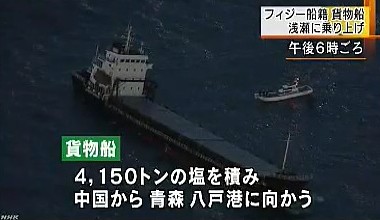
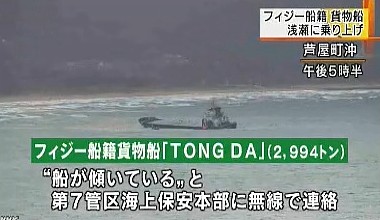
芦屋町の沖合で、フィジー船籍の貨物船が荷崩れを起こして浅瀬に乗り上げました。海上保安部によりますと、乗組員にけがはないということです。
11日午後3時ごろ、芦屋町の沖合を航行していたフィジー船籍の貨物船「TONGDA」(2994トン)から「船が傾いている」と、第7管区海上保安本部に無線で連絡がありました。
巡視艇などが救助に向かいましたが、貨物船は芦屋町の沖合の浅瀬に乗り上げて座礁しました。
貨物船には中国人とミャンマー人など、いずれも外国人の乗組員14人が乗っていましたが、けが人はいないということです。
海上保安部の調べによりますと、貨物船は4150トンの塩を積んで、中国から青森県の八戸港に向かっていたということです。
貨物船の40代の中国人の船長は「荷崩れを起こし左舷側に傾いた」と話しているということです。
海上保安部は、荷崩れが原因でかじがとれなくなり座礁したとみて、油の流出の有無や当時の状況を詳しく調べています。
| From(Maritime Connector.com) | |
|---|---|
| Ship Name: | BORNEO AQUA NO.1 |
| IMO: | 8904599 |
| Type of ship: | FISH CARRIER |
| Flag: | Ship registration withdrawn (EX-MICRONESIA) |
| Gross tonnage: | 299 tons |
| Year of Built: | 1989 |
| Builder: | HONDA HEAVY INDUSTRIES - SAIKI, JAPAN |
| Manager: | SODATRA - DAKAR, SENEGAL |
| Owner: | Salient Horizon Sdn Bhd |
| Former names: | EISHIN MARU NO.8 until 2008 Nov2 |
TAMAYA 1(IMO 7927178,パナマ籍)についていろいろと調べてみました。ISPS(国際保安)コードが国際条約になり、船の経歴を調べるのが楽になりました。東亜運輸株式会社のサイトに
S57.10 絹丸 購入(第五天竜丸へ船名変更)(東亜運輸株式会社) と書かれています。昭和57年は1982年なので下記の情報とも一致します。 たぶん、第五天竜丸が海外へ売船された後、転売が繰り返されてTAMAYA 1(IMO 7927178,パナマ籍)となったのでしょう。
1980年に北日本造船で建造されているので船齢36年。「この大きなタンカー」と下記には書かれているが国際トン数「992トン」は小型タンカー。長さにしても100mは超えていないはず。大事に使わなくても日本製の船は良く持つ証拠でしょう。
| From(Maritime Connector.com) | |
|---|---|
| Ship Name: | TAMAYA 1 |
| IMO: | 7927178 |
| Type of ship: | OIL PRODUCTS TANKER |
| Flag: | PANAMA |
| Gross tonnage: | 922 tons |
| Year of Built: | 1980 |
| Builder: | KITANIHON SHIPBUILDING - HACHINOHE, JAPAN |
| Manager: | SODATRA - DAKAR, SENEGAL |
| Owner: | TAMAYA SHIPPING OFFSHORE - BEIRUT, LEBANON |
| Former names: |
MICHALIS until 2007 Feb VEMACHEM III until 2003 Mar IRENE VII until 1996 Nov TENRYU MARU NO.5 until 1992 Jun KINU MARU until 1982 |
AFPの動画をみると船橋は火事か、故意に焼かれているように見える。乾舷をみると、放置される、又は、売船される前のパナマ船籍船の時に、
INSB(International Naval Surveys Bureau)と呼ばれる検査会社が検査して証書を発給していたと思われる。
INSBのサイトには「INSB Class is a Greek ship classification society and an impartial third party certification organization with almost 4 decades of presence in the global maritime domain....We perform marine safety surveys & approvals for ship classification, statutory and marine management systems certification, for new builds and fleet in service. 」と記載されている。
もし正式にパナマ籍に登録されて売船されたのなら、どこの弁護士事務所が手続きしたのかパナマに記録が残っているはずである。
船籍偽装のケースでは記録は残らない。
この大きなタンカーはリベリアの海岸に座礁するまで3週間姿をくらましていました。
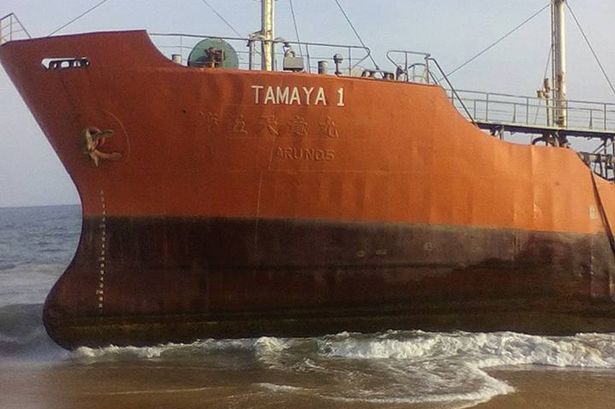
打ち上げられた船はパナマ船籍で、乗組員は見当たらなかった
誰も乗っていないオイルタンカーが浜に乗り上げた事件に専門家は当惑しています。
このTamaya 1号の居場所は3週間に渡って不明でしたが、突如西アフリカのリベリアの海岸に現れたのです。
地元の人は乗組員が誰もいないことに驚きすぐさま通報しましたが、警察は数日間何の対応もとりませんでした。
全長64mの同船はセネガルのダカール港に向け航行中でしたが、4/21を最後に行方が分からなくなっていました。
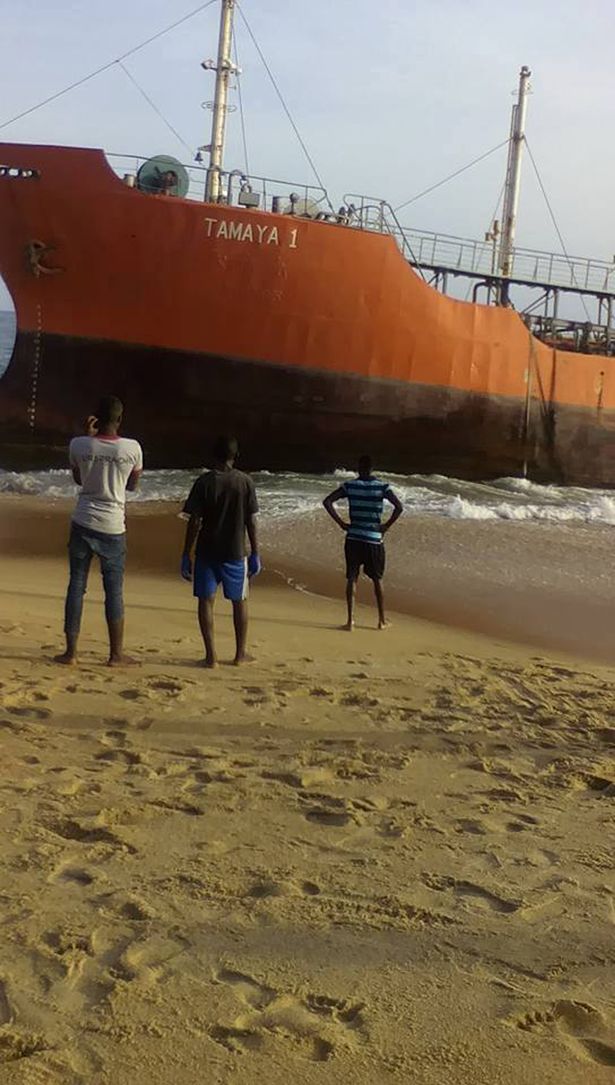
地元住民はすぐに通報したが、警察は数日間に渡って対応しなかった
現在当局が、このパナマ船籍の船がなぜ乗組員も乗せずに打ち上げられているのか捜査をしています。
港湾当局の関係者によりますと、「最も可能性が高いと見ているのは、船主が破産し乗組員に給与を支払えなくなったという線だ。その結果乗組員は船を放棄したのではないか」とのことです。
船は略奪・破壊された状態で浜に乗り上げており、この怪事件が海賊による仕業ではないかとの根強い声があると報道されています。
警察は捜査中、地元住民が近づかないようにしているとのことです。
The huge ship vanished three weeks before it washed up on the shores of Liberia

Experts are baffled after a huge oil tanker washed up on a beach with nobody on board.
The Tamaya 1's position hadn't been recorded for three weeks when it mysteriously appeared on the shores of Liberia in west Africa .
Locals were shocked to find that there was nobody on board and immediately raised the alarm – but police didn't respond for days.
The 64-metre tanker was on the way to the Sengalese port of Dakar and it was last seen on 21st April.

Now officials are scrambling to work out why the Panama-registered vessel washed up with no crew.
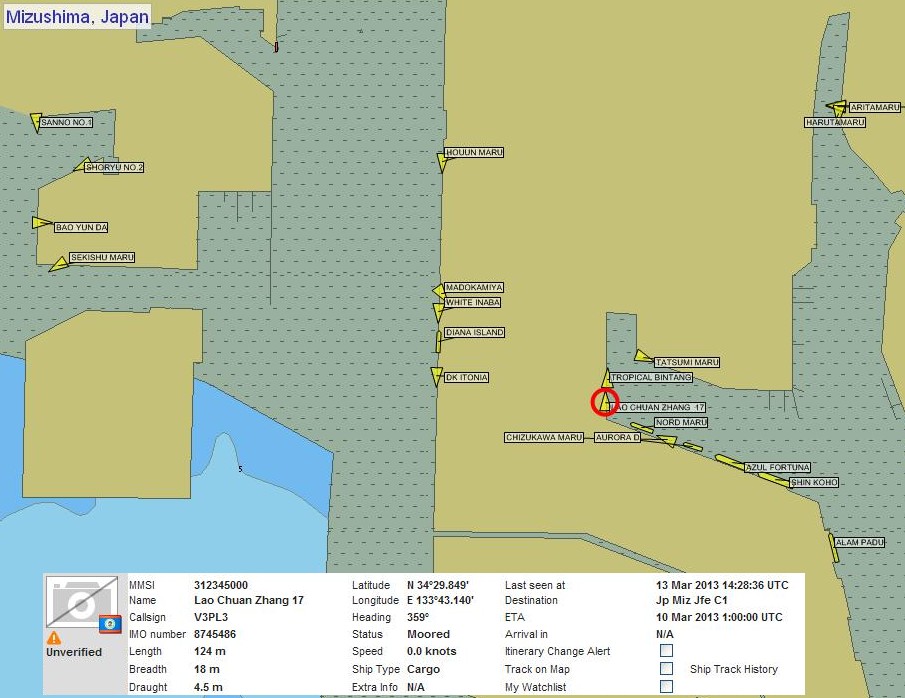
|
|
|
|---|---|
| Lao Chuan Zhang 17 ((ShipSpotting.com)) | Lao Chuan Zhang 17 ((ShipSpotting.com)) |
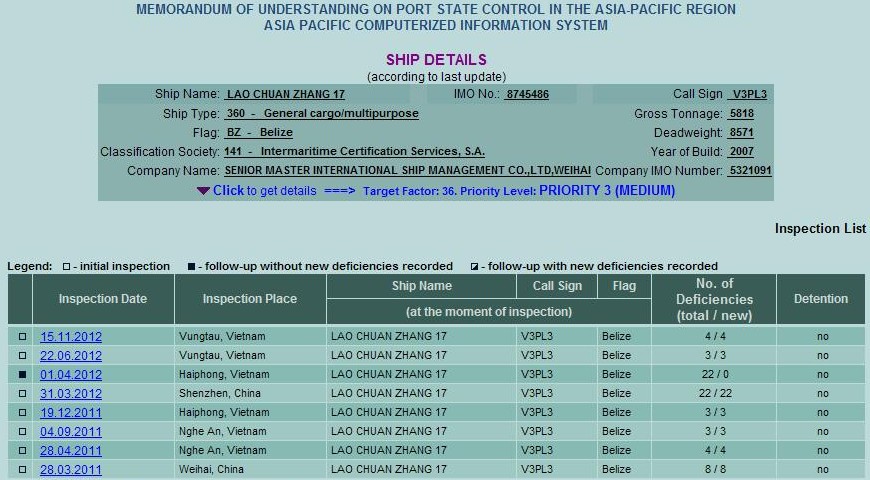
利尻富士の貨物船座礁について少し書く。
無国籍の船でも韓国を出港できることをはじめて知った。それが本当であるとすれば、
韓国におけるPSCはどうなっているのだろうか?
(海の記録 Memories on the seaのHPより)
聞いた話だが、韓国では通関が要求されるエリアよりも沖にアンカーしている場合、
外国船として税関に報告する必要はないそうだ。
無国籍の船の入港
や
無国籍の船の出港は日本でも可能です。
日本でも起きています。だから韓国におけるPSCだけの問題でなく、日本のPSCや
日本の保安庁のチェックも甘い
と言う事です。問題を指摘しても尾道では無国籍船が出港しています。テレビで放送されて
いないだけなのです。これが日本の現実です。
誰も保安庁を非難しない。そして非難されないから適切な対応を取らない?又は取るだけの
能力がない?テレビでは保安庁の良いとこだけを取り上げる。大きな誤解だと思う。「テロ」とか
大げさに日本でも取り上げられるが、日本は「テロ」や取締りが甘いと思う。だから「テロ」と
か言っても、「勝手にやってください。だけど、税金の無駄使いはやめてね」と思っている。
結構、言いたい事を書いているが、未だに尾道からはこんな状態でよいのと思う船が税関から
輸出許可を受け、出港している。
社会保険庁職員と社会保険事務局職員は必要なし
と思うけど、公務員の問題はたくさんあると言うこと。もっと批判しないと変わらないのだろう。
これからも批判するけど、変わる可能性は低いと思う。
無国籍船であっても結構、捕まらない!これが事実か!
船舶油濁損害賠償保障法:
日本の港に入る100トン以上の外国船舶に船主責任保険(PI保険)の加入が義務づけられた
は関係ないのかな???
なぜ海上保安庁は国籍証明書が1年半前に失効した無国籍の
貨物船「デルベント号」(602トン)の問題を見つけられなかったのか?
船舶油濁損害賠償保障法
は無意味なのか?取締りが甘いのか?それとも、日本の領海を通過する100トン以上の外国船舶に対しても
船主責任保険(PI保険)の加入が義務付けを要求するべきだ。
座礁した事件で船舶の所有者に撤去命令が出来るだろう。船主責任保険(PI保険)なしで航行しても
座礁した時点で、違法が判明する。現在の船舶油濁損害賠償保障法よりはマシなことは明らかだ。
参考情報(海の記録 Memories on the seaのHPより)
◇船主との交渉難航
利尻島の海岸(宗谷管内利尻富士町沼浦)にロシアの運送業者が所有する貨物船「デルベント号」(602トン)が元日に座礁して1カ月以上が経過した。同町は船主に一刻も早く撤去するよう迫っているが、国籍証明書が1年半前に失効した無国籍船であるうえ、船主責任保険などの船体保険に入っていないため、撤去には多額の費用が必要。船主との交渉は難航し、解決のメドは立っていない。【岸本悠】
問題の貨物船は1月1日午後7時ごろ、韓国からサハリンに向かう途中、1等航海士が居眠りしていて流され、砂浜に座礁した。稚内海保は同4日にタグボートで船を移動させようとしたが、船底が砂の中に1メートルも埋まっていたため断念。同15日、1等航海士を業務上往来危険容疑で逮捕し、稚内簡裁が罰金15万円の略式命令を出した。
現場は特産の利尻昆布の養殖場に近く、海岸から数十メートル入ったところは約20戸の集落。船内に残っていた船員13人は今月4日、稚内市の旅館に移ったが、それまでは暖を取る発電機の稼働音が夜中も周辺に響き、住民は不安を訴えていた。
海岸に面した石川ヨネさん(83)方の玄関先に出ると目の前に船体が迫る。石川さんは「家がサーチライトで真っ赤に照らされて火事と勘違いして飛び起きたこともある。(船員は船を離れたが、船体も)早くどこかにやってほしい」と話す。
同町は貨物船の燃料を抜き取り、漁協がロープで船体を固定した。しかし、大しけになれば船が倒れ、残った油が漏れる可能性もある。田村祥三副町長(54)は「そうなれば昆布やウニの漁場が大被害を受ける。損害は何千万円になることか……」と頭を抱える。
今月3日になってようやくモスクワから船主の男性(31)が稚内入り。日本の業者に撤去を頼むと数億円かかるため、サハリンの海難救助局のサルベージ船を使う意向を示したが、具体的な時期は未定のまま。撤去が実現しても、作業が周辺漁場に悪影響を与える恐れもある。
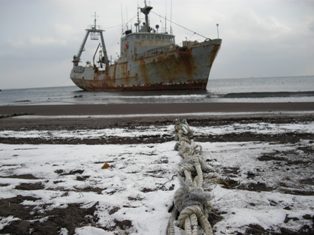
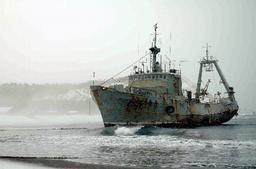 北海道北端の利尻島の浜辺に1日夜、無国籍の漁船が座礁し、撤去の見通しが立たないまま船員らは厳寒の荒海で船中に缶詰め状態になっている。けが人や油の流出はないが、船主責任(PI)保険に未加入で救出や撤去費用のあてもなく、漁業と観光で暮らす地元も新年早々の思わぬ「来客」に途方に暮れている。
北海道北端の利尻島の浜辺に1日夜、無国籍の漁船が座礁し、撤去の見通しが立たないまま船員らは厳寒の荒海で船中に缶詰め状態になっている。けが人や油の流出はないが、船主責任(PI)保険に未加入で救出や撤去費用のあてもなく、漁業と観光で暮らす地元も新年早々の思わぬ「来客」に途方に暮れている。
地元の利尻富士町の漁協から稚内海上保安部に「島の南西部で外国船が座礁した」と通報があったのは1日午後8時。韓国からロシアを目指す途中、見張り不足で座礁したという。当初は無線の呼びかけにも答えず、ロシア人やウクライナ人計14人が乗ったデルベント号(602トン)と判明したのは2日朝。カンボジア船籍を名乗ったが、06年7月で船籍の期限が切れた無国籍船だった。
周辺には昆布の養殖施設があるため早々に脱出させようとしたが、タグボートのワイヤが切れるなどして断念。燃料の重油を抜き取るなどし、サルベージ会社を呼んで撤去方法を検討している。
問題になっているのは、町や地元業者が撤去したとしても費用がきちんと回収できるかが分からない点。この船は日本に寄港予定がなかったため、日本に入港する100トン以上の外国船に義務づけられているPI保険に入っていなかった。 同町は「船体を残して逃げられては困る」と、荒天で危険が差し迫らない限り船員を受け入れない方針。船主は稚内市の船舶代理店を通じて宿泊施設を見つけようとしているが、素性が知れないだけに応じる業者もなく、食料は船内のものや町の人に頼んで買ってしのいでいるという。
***
韓国は釜山の影島の船だまりに長期間つながれていたようなトロール船である。通常は韓国で手入れをしてからロシアに向かうはずだが、この写真から見ると外舷のペイントアップも行われていない。極東ロシアの冬に船体の手入れはまず無理。襤褸船であることを覚悟の上での回航は何のためのものか。無国籍の船でも韓国を出港できることをはじめて知った。それが本当であるとすれば、韓国におけるPSCはどうなっているのだろうか?
自分も一度だけ座礁を経験した。船体振動があって座礁とわかり、船尾甲板から見ると、水中に砂煙があがった。後はお手上げであった。幸いにも潮待ちをして離礁することができた。船底の痛みやプロペラの損傷もなかった。一時はいかにして船を軽くするかが課題であった。こういう経験を練習船でしてしまったわれわれであった。館山湾でのアンカートラブルにはじまり、ありとあらゆるトラブルを体験させられたのがこのS丸の処女航海であった。青春の夏であった。
“無国籍”貨物船「第38コスモスター」として半年間以上下関港で係留されていた「第38コスモスター」
(今回もホンジュラス籍のようだ)が2007年8月8日、再度、
PSC
により出港停止を受けたと書いたが、その後、
東京MOUのHP
から「第38コスモスター」のデータが消された。理由は不明???
山口新聞
によると下関港に3年以上にわたって係留されていると書かれている。
そして2007年1月16日には下関港を出港したと書かれている。
貨物船「第38コスモスター」は再度、下関港へ入港したのだろうか?
なぜ、貨物船「第38コスモスター」が2007年8月8日に出港停止命令が出されたと
東京MOUのHP
に掲載されそして、消されたのか、全く分からない。貨物船「第38コスモスター」
はPSCにより検査されたのか、公になることで問題が起きる何かが会ったのか、
全てが闇である。
下関港に3年以上にわたって係留されていた無国籍の貨物船「第38コスモスター」(297トン)が16日、タグボートにえい航され、同港を出港した。
所有する福岡県内の貿易会社の関係者によると、北九州市内の業者のもとに運ばれ、修繕や解体を検討するという。この関係者は「迷惑をかけ続け、申し訳ない。船を動かせてホッとしている」と話している。
下関市港湾局などによると、コスモ号は2003年10月、無国籍の状態で、北朝鮮から下関港に入港。国交省の船舶安全性検査(PSC)で船体の不備や国籍切れなどが判明し、改善するまで出港できなくなった。
岸壁の使用料は04年4月から未払いになり、下関市側が、船体の撤去や使用料の支払いを貨物船側に要請。貨物船側は応じる姿勢を見せながらも実現しなかったため、市側は昨年12月、提訴する方針を固め、議会側も了承していた。
貨物船側の関係者は「未払いの係留料は当然、支払うことになる」と話しており、市港湾局総務課も「実際に提訴するか検討する。未払いの使用料についても、貨物船側と交渉していく」と柔軟な姿勢をみせた。
下関港に3年以上にわたって係留されている無国籍の貨物船について、下関市は、貨物船の所有者の貿易会社と代理店を相手に、船の撤去や滞納中の使用(係留)料金計約376万円の支払いなどを求める訴訟を起こす方針を決めた。12月定例議会に訴訟議案を提案する。
貨物船は「第38コスモスター」(297トン)で全長約48メートル。所有者は福岡県内、代理店は下関市内の業者。同港の第1突堤13号岸壁に係留されている。
市港湾局総務課によると、貨物船は2003年10月に入港。ところが、国交省の船舶安全性検査(PSC)で、無国籍だったことや船体の不備などが判明し、改善するまで出港できなくなった。
岸壁の使用料金をめぐっては、貨物船側が04年3月末までの料金を支払っていたが、その後は滞納が続いた。市港湾局は再三にわたって所有者に撤去を求めたが、今月29日現在も係留されたままだ。
所有者の貿易会社によると、自力航行で出港するためには、国籍の所有やPSCで指摘された船体の改善が必要だが、国籍取得や改善費などに莫大な費用がかかるという。業者は、取引のある北朝鮮からえい航船を呼び寄せる予定だったが、経済制裁の実施で頓挫しているという。
“無国籍”貨物船「第38コスモスター」として半年間以上下関港で係留されていた「第38コスモスター」
(今回もホンジュラス籍のようだ)が2007年8月8日、再度、
PSC
により出港停止を受けた。
(東京MOUのHPより)
今回は、本当にホンジュラス籍なのであろうか。「第38コスモスター」を検査した検査会社は
「Other/JOSON CLASSIFICATION SOCIETY OF D.P.R. OF COREA」だ。
(東京MOUのHPより)
つまり、北朝鮮の検査会社。さほど期待などしていないが、
PSC
と
海上保安庁
が調べるであろう。
国籍のない貨物船「第38コスモスター」(297トン)が下関港の13号岸壁に係留されたまま約半年以上 立っているそうである。
国籍のない貨物船「第38コスモスター」(297トン)が下関港の13号岸壁に係留されたまま約半年。自力航行できず、九州運輸局は「海上に浮いている物体に過ぎない」と言う一方、下関市港湾局は「船に変わりはない」と食い違いを見せている。所有者側は「5月末までに出港させる」と港湾局に連絡しているのだが……。
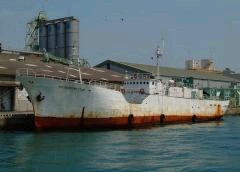 ■考えられない無国籍
■考えられない無国籍
船が北朝鮮・興南から入港したのは昨年10月30日。九州運輸局が船舶安全性検査を実施した結果、無国籍が判明した。船は1971年に建造。元々は日本の冷凍運搬船で、その後、ホンジュラス国籍を取得したが、2年前に税金未納で除籍されたという。エンジンルームは損傷、船体も腐食。37項目の違反のうち、うち重大な22項目について、改善命令が出され、是正するまで出港できなくなった。同運輸局は「無国籍で公海を航行すること自体、考えられない」とあきれる。
■盗難車輸送船
入港から19日後、所有者とされる福岡県新宮町の貿易会社社長が、盗難車と知りながら買い取ったとして、福岡県警に逮捕された。車を船に積み込み、北朝鮮に運び出していたと見られている。その後、船長らが下船、見張り役1人だけとなった。運輸局は「航行に必要な乗組員がおらず、整備も不完全。船とは見なせない」と判断。
■係留料不払い
「使用者は港湾施設の使用に際し、貨物その他の物を放置し、又はみだりに滞留してはならない」(市港湾施設の設置等に関する条例施行規則)。運輸局の判断では、「貨物その他のもの」となり、岸壁の使用許可を取り消し、行政代執行で撤去、その費用を所有者か代理店に請求できる。従わなければ、5万円以下の過料を科すことができる。
ところが、市港湾局は「入港したときは船だったので、今でも船舶として扱っている。使用を許可している以上、滞留には当たらない」としている。「出港する意向を示しているので、今は強制撤去については考えていない」と、“待ち”の姿勢だ。
「船」の係留には使用料が必要。同船の場合、1か月当たり約12万円。現在までの合計金額約70万円は市に支払われていない。岸壁使用許可の申請をしている市内の船舶代理店を相手取って提訴できるが、港湾局は「支払うと約束している。期限を守られない時は検討したい」と言う。
■不透明
貿易会社側は、3月31日、港湾局に「5月末までに、使用料を支払い、出港させる」と文書で通知してきたが、具体的な方法、日時、行き先は不明だ。
ここで「同運輸局は「無国籍で公海を航行すること自体、考えられない」とあきれる。」と 書いてあるが、一体、船舶の国籍は誰が責任を持ってチェックするのだろう。「第38コスモスター」の 事件以前に、偽造の国籍証書で尾道糸崎税関で輸出許可を取り出港した船舶、国籍証書が無効となって いるにも係わらず、尾道糸崎税関がある国籍として船舶を認めた例などがある。尾道糸崎税関のある職員 によると偽造の国籍証書であっても、輸出許可を出す手続きには問題ないそうである。また、国籍証書が 偽造であったり、無効であっても、それらをチェックする義務も責任もないそうである。
「第38コスモスター」は、北朝鮮問題で運悪く発覚した氷山の一角かもしれない。船の定義とは一体 どのようなものなのであろうか。国籍がないものや抹消されたものは、船なのであろうか。 船の形をしていれば、船と認められるのであろうか。上記の記事の写真の船は、もともと貨物船でなく 漁船であると思われる。
The Indian Coast Guard のHPより
For the first time in the country, an incident of diesel smuggling came to light when the Indian Coast Guard apprehended a foreign oil tanker engaged in illegal selling of diesel off Mumbai coast. The 62-metre long vessel A1-Rehmat, which sailed out from Umm-a1-Quwain, United Arab Emirates with 890 metric tons of diesel, was bound for Colombo, but it never reached the destination and stayed outside Mumbai anchorage for about 20 days. During this period, the vessel transferred about 460 metric tons of diesel to a barge Rajveer. Thereafter, the vessel left Mumbai anchorage for another mid-sea transfer off Gujarat coast.
An extensive search was launched by the Coast Guard ship Veera, which was on patrol duty off Gujarat coast. Despite rough sea and poor visibility in the area due to inclement weather, CGS Veera finally intercepted the vessel about 62 nautical miles south west of Porbandar. The ship's boarding party carried out initial investigation and observed certain irregularities and suspected the vessel to be involved in some nefarious activities. Accordingly, the vessel was brought to Porbandar Harbour for detailed investigation by Coast Guard and Customs.
The oil tanker, Al-Rehmat, possessed a Honduras registration. On enquiry, Honduras Shipping Registry confirmed that the vessel is not registered in Honduras. On further investigation, the Panamian certificates of the Master and Engineer were also found to be fake. Not only this, the bill of lading and bill of export carried by the vessel were also not genuine.
Out of eleven crew present onboard, 10 were Indians and one Nepali. After grilling the crew, it was found that the diesel brought from Gulf countries was sold at a cheap rate on the Indian coast evading customs and excise duties.
The vessel whose earlier name was MT Rakhmat was more than 30 years old. As per Merchant Shipping Act, vessels of more than 30 years in age are not permitted to operate on Indian ports due to safety reasons. This was the first time in India when smuggling of diesel at sea had been detected.
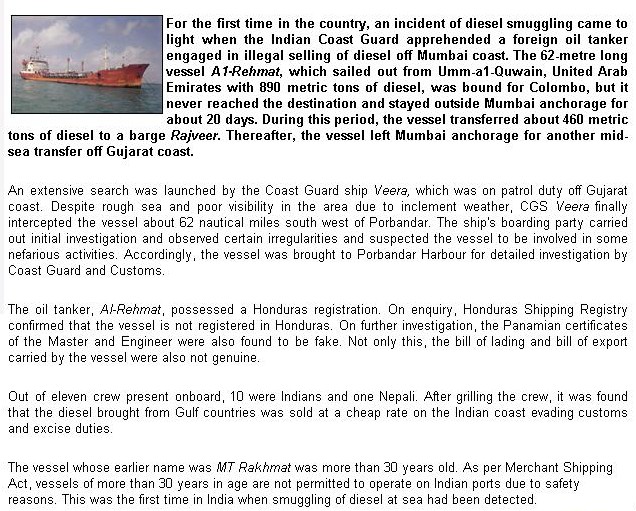
インドでも国籍のないタンカー「A1-Rehmat」がインドのコーストガード(日本で言う保安庁みたいな組織)により 見つけられている。この船も貨物船「第38コスモスター」と同様にホンジュラス国の国籍証書を持ち、 ホンジュラス国籍となっていた。しかし、Honduras Shipping Registry (ホンジュラス海運局)に 問い合わせると該当する船舶は登録されていないことが確認された。
また、船長及び機関長が所持していた免状も偽造であることが発覚した。日本がどのような対応を しているのか良く知らないが、偽造書類の対応を考えていなければ適切な対応を迅速しなければならない。 広島県警は何も出来ないと言った。これは事実である。
九州運輸局は「無国籍で公海を航行すること自体、考えられない」とあきれるのは勝手であるが、 保安庁と協力し、このような無国籍船や問題のある旗国が犯罪に使われていることをもっと 理解しなければならない。そして、厳しい検査及び対応をしなければいけない。
オーストラリアの領海で船名「JIAN SENG」と書かれた幽霊船が発見されたそうだ。
2006年3月25日にオーストラリア税関職員が乗り込んだところ、誰もいなかった。
船名以外、照合する情報が残されていなかった。エンジンは使用不可能で、スタート
することも不可能だった。
船名から推測すると中国船。長さが80mもあるのであれば、国際トン数で
500トン以上。IMO番号が書かれていないのは不思議。各国が自己努力で
取締まるしかないだろう。
The Cargo Letter Vessel CasualtiesのHPより
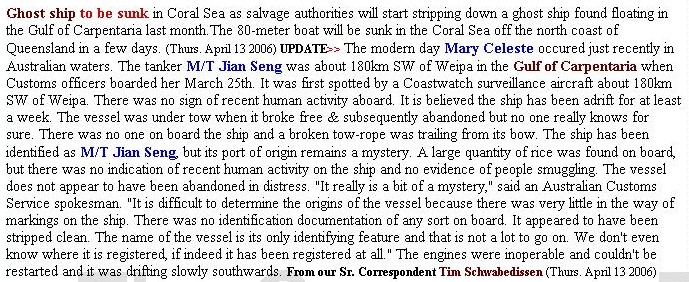
Customs boards 'ghost ship' in Gulf of Carpentaria - Monday, 27th March 2006
Officers from the Australian Customs Vessel (ACV) Storm Bay have boarded an abandoned tanker in the Gulf of Carpentaria this morning around 180km south-west of Weipa.
There is no one on board the vessel, which is estimated to be 80m in length and is trailing a broken tow-rope from its bow.
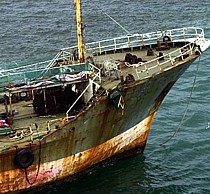 It has been identified by the boarding party as the Jian Seng but its port of registry and nationality is unknown.
It has been identified by the boarding party as the Jian Seng but its port of registry and nationality is unknown.
There is no suggestion there has been anyone on board recently, or that the vessel has been used in any people smuggling activity. There is no indication the crew left the vessel in distress.
A large quantity of rice was found on board and Customs officers believe the vessel may have been used to resupply fishing boats with food and fuel in waters outside Australia's Exclusive Economic Zone.
The vessel has been disabled for some time. Based on a search of the Jian Seng the Customs boarding team believes the vessel was under tow when it broke free and was abandoned before drifting into Australian waters.
The vessel's engines are inoperable and it is still drifting slowly southwards.
It was spotted yesterday (Friday) by a Coastwatch surveillance aircraft. The aircraft was unable to establish radio communication and the Storm Bay was asked to investigate.
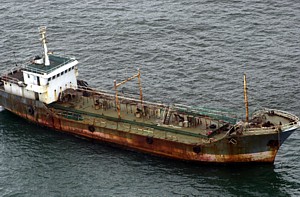 While Customs has no further interest in the vessel, it is considered a navigation hazard. The Storm Bay is monitoring the vessel's drift and Customs is liaising with the Australian Maritime Safety Authority on appropriate action to secure the vessel.
While Customs has no further interest in the vessel, it is considered a navigation hazard. The Storm Bay is monitoring the vessel's drift and Customs is liaising with the Australian Maritime Safety Authority on appropriate action to secure the vessel.
The vessel is the second 'ghost ship' to appear in Australian waters in recent years. The Taiwanese fishing vessel High Aim 6 was found drifting off the NW coast of Western Australia in January 2003. A subsequent search and investigation found no trace of the crew and it was later sunk as an artificial reef off Broome.
「人民網日本語版」2004年6月4日の記事によると
天津税関、韓国へのコークス密輸船を調査
したそうである。
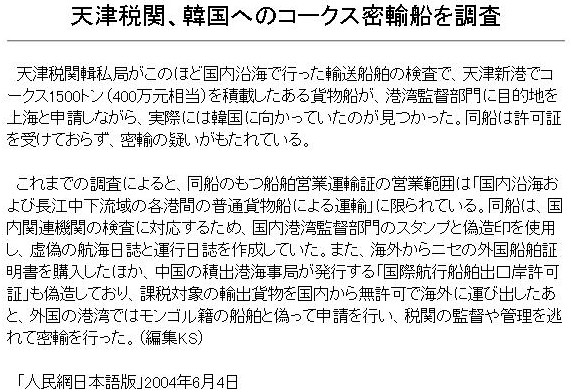
天津税関輯私局がこのほど国内沿海で行った輸送船舶の検査で、天津新港でコークス1500トン(400万元相当)を積載したある貨物船が、港湾監督部門に目的地を上海と申請しながら、実際には韓国に向かっていたのが見つかった。同船は許可証を受けておらず、密輸の疑いがもたれている。
これまでの調査によると、同船のもつ船舶営業運輸証の営業範囲は「国内沿海および長江中下流域の各港間の普通貨物船による運輸」に限られている。同船は、国内関連機関の検査に対応するため、国内港湾監督部門のスタンプと偽造印を使用し、虚偽の航海日誌と運行日誌を作成していた。また、海外からニセの外国船舶証明書を購入したほか、中国の積出港海事局が発行する「国際航行船舶出口岸許可証」も偽造しており、課税対象の輸出貨物を国内から無許可で海外に運び出したあと、外国の港湾ではモンゴル籍の船舶と偽って申請を行い、税関の監督や管理を逃れて密輸を行った。(編集KS)
問題船や無国籍船は知られていないだけで日本内に存在するかもしれない。 外国で発見されているのだから、可能性は否定できない。
船の形が典型的な漁船である。山口で座礁し撤去された北朝鮮貨物船も 漁船として建造され、貨物船と呼ばれていた。下記の記事を参考にしてください。
同じような問題が起きないようにするためには、税関、運輸局、及び港湾局が、外国籍船舶の定義を 統一して対応するべきであろう。問題を放置することは次の問題を引き起こす原因となる。 また、税関、運輸局(PSC)及び港湾局が協力するような体制を作る必要がある。 お互いに責任をなすりあいし、自己防衛をするおろかな結果にならないようにしてほしい。
結構、ずさんに登録できる旗国は、アルファベット順にベリーズ、ボリビア、カンボジア、 ホンジュラス、モンゴル、パナマである。詳しくはわからないが、時々、マーシャル諸島 に登録された船が出港しているようである。仮登録するのに船級(承認されている検査会社) の検査を必要としない。厳しい旗国では、検査証書を所持していることを証明できないと 航海できる国籍証書を発行しない。つまり、国籍証書(旗国に登録されている)はあるが、 船は自航できないと書かれているのである。国籍証書を所持していれば、問題があるままの 欠陥船で出港してしまう日本では、厳しい検査が必要であろう。これらを参考にチェックすれば、 効率良く検査できるであろう。
Lloyd's Register - Fairplay - のHPより
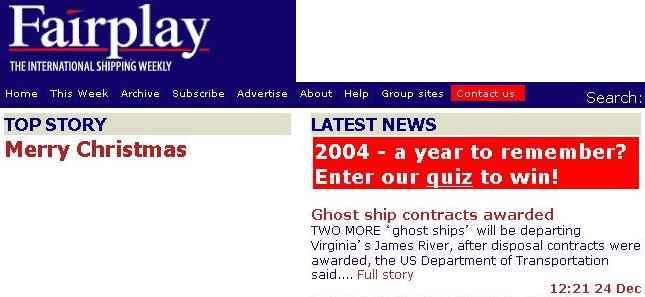
無国籍船&幽霊船について、アメリカでは運輸省が扱っているようです。
日本は、たらい回し、責任逃れが優先みたいです。
国籍証書とトン数証書を税関へ提出するようになっているので、
国籍証書を確認していれば、無国籍船&幽霊船であるかは確認できるはず。
税関の中には、尾道糸崎税関のように国籍証書が無効と指摘されても
確認しない税関も存在する。結局、無国籍船&幽霊船を許した税関、保安庁、
海運局の責任である。ウソの報告を税関と保安部にする
船舶代理店も存在するようなので、このような問題を放置する日本にも
問題がある。これで国連常任理事国に大金をはたいても日本はなりたいよう
なので、滑稽である。第一にやることをやる。国内の問題も解決する。
先送りはしない。こんな事さえも出来ないのに、税金の無駄使いするなと言いたい。
下記は、上記の参考情報です。
次の更新まで続く。
「通関は地方が狙い目!」と聞いて何を思うだろうか。ブランド品のスパーコピーや虚偽の 輸入書類が地方税関に持ち込まれるようになっているとテレビで見たことがある。船の世界も おなじなのだろうかと思う人もいるかもしれない。都会の税関よりも地方税関のほうが審査が 甘いのかもしれない。しかし、それだけではない。税関の中には、無国籍船と知りつつも、 知らないふりを組織的にした税関もあるのである。もちろん、道警のように裏金作り(不正流用):朝日新聞 の事実はないと言われれば、誰も調べない事である。 このような体質 があるので、それを利用する 船舶代理店や業者がおかしなことをするのであろう。悪いことをするほうも悪いが、それを 許す体質にも問題があると思う。
税関について言えば規模が小さいほど担当の裁量次第なので、担当に問題がある場合、 担当が代わるまで問題は改善されない。誰も権限のある担当者をチェックしない。 公務員について性善説を唱える人もいるようであるが、「そうあるべき」との理想や期待だけで 一般の人達と変らない。 警察の不祥事 や捜査の対応をみると、法と秩序を守るために警察で あっても、現実は違うと思っている人もいると思う。「構造改革」と叫ばれて、時は経つが 公務員の意識改革も必要であろう。
実例を使って税関の問題を指摘したいと思う。このHPを見た当人は覚えているのだろうか。
これは尾道糸崎税関に書類が提出された外国籍船舶に関する書類である。船舶○○2の 国籍は、2000年5月29日で無効となっている。なぜ、2000年8月14日以後も尾道税関は 国籍が抹消されている船舶をベリーズ籍船として扱ったのか。問題はこれだけでない。 尾道糸崎税関から通関を受けたある船舶は、偽造の国籍証書で通関を通っていたのである。 広島県警に問い合わせたところ、犯罪にならないとのことでした。広島県警も良く調べた 後での回答でしょうから、法の抜け道があるのでしょう。 有印私文書偽造・同行にならないのでしょう。 牛肉偽装問題では、立件されるようですが!! 座礁してもおかしくない 状態の船舶が日本から出港して、座礁するのは不思議なことではない。現状なこんな状態 です。警察や税関は自分達には関係ないと縦割り行政の問題を主張すれば良い。 だから、今後も何も変わらないでしょう。
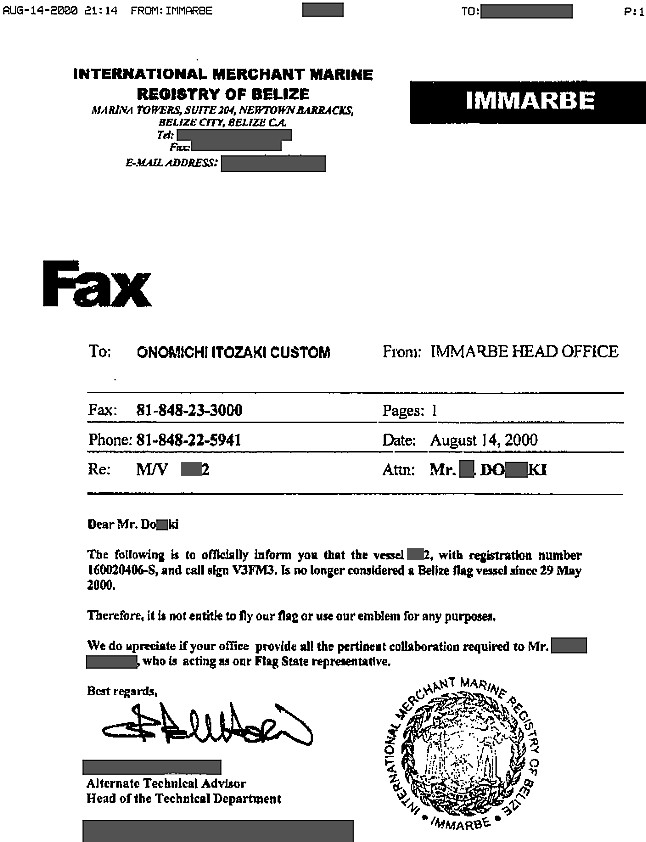
これでは野放し状態である。尾道税関のD氏は、上記の事を知っているにもかかわらず、 知らないふりをした。その後、偽造の国籍証書で船舶の通関がおこなれたこともあった。 これでは、いろんな問題が税関で起きたのも納得できるような気がします。この問題は氷山の 一角かもしれません。現在でも同じ状態なのでしょうか?
おもしろい記事を見つけました。警察や税関が上記のような事件を無視しつづけるので下記の ような事に利用されるのでしょう。北朝鮮問題に利用されたから問題なのでしょうか。 このような問題を放置し、無視を続けた税関やこのような問題に取組まない警察の責任でも あると思われます。ある事件で大きく取り上げられるまで無視する体質は、公務員病かもしれません。 ある船舶の国籍が無国籍であった事実が判明した後も、適切な対処をしなかった尾道糸崎税関、 国籍証書が偽装であったことが発覚した事件を調査しなかった広島県警。そして、山口で 無国籍貨物船が見つかった。これは氷山の一角かも知れません。警察は、少なくとも 裏金作りを やめてほしいですね。また、警察は、警察官としてでなく、モラルとインテグリティーある人間として 裏金作りの否認するのをやめてほしいですね。 三菱自動車と同じ体質かもしれません。
山口・下関港で、国土交通省所管の船体検査で欠陥がみつかった無国籍貨物船が、約四カ月間も“無銭停泊”を続け、軍需やハイテク産業への再利用可能な貨物を北朝鮮に運びだそうとしていた可能性が高いことが四日、分かった。日朝間を結ぶ貨物船で、福岡県の在日本朝鮮人総連合会(朝鮮総連)幹部経営の会社が事実上所有。この船は以前にも、同様の貨物を北朝鮮に積み出しており、公安当局などでは、船籍を偽装登録する方法での北朝鮮への“密輸”を警戒している。
貨物船は「第38コスモスター」(二九七トン)。昨年十月三十日、北朝鮮の興南港から天草などの海産物約二十トンを積んで下関に入港。九州運輸局下関海事事務所による船体安全検査(ポートステートコントロール、PSC)で三十数カ所の欠陥が見つかり、技術基準適合命令が出された。
貨物船は当初、船籍をホンジュラスと申告。だが船内に北朝鮮で発行された「トン数証書」や「満載喫水線証書」があり、ホンジュラスに確認したところ、船舶登録料滞納で約二年前に登録抹消され、無国籍状態だった。
コスモスター号が下関を出港するには、国籍を確定したうえで欠陥の是正が必要。しかし、PSCの適合命令の対象となる船長(インドネシア人)が二月中旬に帰国し、PSCが中断。入港時から昨年十二月末までの岸壁使用料約二十五万円が支払われていない。
港を管理する下関市港湾局は船の自主的出港は困難と判断。所有者側に撤去を求める方針だが、「法的な問題で(強制撤去できるか)分からず、判断しかねている」と困惑している。
現在の法律では、こうした船舶の入港を制限することは困難だが、今国会で「特定船舶入港禁止法案」が可決・成立し、北朝鮮に発動されれば、北朝鮮に寄港した船舶の日本入港は阻止できる。
コスモスター号は昨年五月二十四日に下関に入港後、博多港に回り、冷蔵庫約百六十台や自転車約五百台、古タイヤ約九十本、洗濯機二十三台を積み込み、北朝鮮に向かったことが分かっている。荷物は、北朝鮮国内で軍需やハイテク開発に転用できる「中古戦略リサイクル物資」だった。
その後、この船が盗難自動車の輸出に使われていたことも発覚。福岡県警は昨年十一月、盗品等有償譲り受けの容疑で、実質上の同船所有者である福岡県の貿易会社の社長を逮捕、船内を捜索した。社長は福岡県の朝鮮総連幹部でもある。
公安当局などでは、北朝鮮への中古戦略リサイクル物資の運搬を隠すために船籍をホンジュラスにするなど、偽装工作が恒常化している可能性もあるとみている。
◇
≪中古品の戦略リサイクル≫日本から北朝鮮に輸出される自転車や家電製品などには、燃料への転用や兵器の部品、製造、ハイテク製品の開発にリサイクルできる物資が多く含まれる。中古自転車からは、回転構造をもつ兵器部品に転用できるベアリングが得られるほか、古タイヤは燃料、石油化学素材として活用。冷蔵庫は冷却剤のフロンガスがICチップの洗浄に利用されているとみられる。北朝鮮のハイテク産業を支え、外貨獲得や兵器転用に利する懸念があるが、法的規制はない。
「公安当局などでは、船籍を偽装登録する方法での北朝鮮への“密輸”を警戒している。 」と書いて ありますが、国籍によっては二重国籍も可能です。違法でも何でもありません。何が問題なのか分かりません。 国籍が偽造である事や船舶が無国籍であることが問題なのであるならば、尾道の事件はどうなるのでしょうか。 尾道の税関では、偽造された船舶の国籍証書を提出しても、輸出許可に関して問題はないし、 偽造であるかの確認をする義務もないとのことでした。こうしていろいろと考えると日本の制度は ざる状態であることに気が付きます。牛肉偽装問題も同じレベルだと思います。
今年から 国際船舶及び港湾施設保安コード(ISPSコード) が適用されます。ISPSコードに頼るしかないのかもしれません。
名古屋港のHPを参考にしてください。 港湾施設保安対策(ナゴヤ・ポート・ニュース12月号)
ISPSは、「国際航海に従事する旅客船と総トン数500トン以上の貨物船が使用する港湾施設には、 平成16年7月1日までに、①国による港湾施設保安評価②施設管理者による港湾施設の 保安計画の策定と保安職員の配置を義務づけました。」
国際クルーズフェリーの爆破情報があったとの想定で、名古屋海上保安部や愛知県警、名古屋入国管理局などが12日、名古屋港に停泊したフェリー「いしかり」を使って合同のテロ対策訓練を行った。
合同訓練は、政府が主要港にテロ対策のための港湾危機管理官を設置後、全国で初めて。
訓練では、海上保安庁の潜水士が船体外部の不審物を海中で捜すとともに、防弾チョッキを着用して強化プラスチックの盾を持った特別警備隊員らが船内を捜索。ロッカーに隠れていた不審者を見つけると、拳銃を突きつけて5人がかりで制圧し、逮捕するなど緊迫感があふれた。
また入国管理局と名古屋税関が爆発物を持った下船者を発見、県警機動隊の爆発物処理班が処理した。(共同通信)
上記でお分かりのように国土交通省が真剣に取組めば、名古屋港のように港湾危機管理官 (ISPSでは港湾施設保安職員:PFSOと呼ばれます)を設置して、セキュリティーの質を上げること できるのです。密航も簡単に出来なくなるでしょう???
こんなことを書くと、どこかの税関の広報の人間ように電話で脅しをかけて来るのだろうか。 あの時ほど税関には信用できる人と出来ない人間がいることを実感したことはない。 嘘で脅したと感じたのは、他の税関職員の助言でわかった。皮肉な事である。悪い奴ほど、 いい思いをするんだろう。
門司税関苅田出張所のHPの「情報ください」で、このような場面に遭遇したら・・・の ページがある。簡単にわかりやすく、絵を使ってあやしい行動と犯罪の関係を説明している。
おもしろい。税関や保安庁のために問題のある船舶代理店のバージョン作るとすれば、下のようになるだろう。
1.問題のある船を扱う代理店はだいたい決まっている。
2.問題船を扱う代理店はポートステートコントロールに引っかかる船ばかりを扱う。
3.問題のある代理店は、嘘を平気で税関や保安庁に言う。
4.問題のある代理店は、紳士的でない。礼儀がなっていない。教育されていない。
5.問題のある代理店を放置する税関や保安庁では、問題船が入出港する確率が高い。
6.5に関連するが、問題を放置するので、問題船が集まってくる。
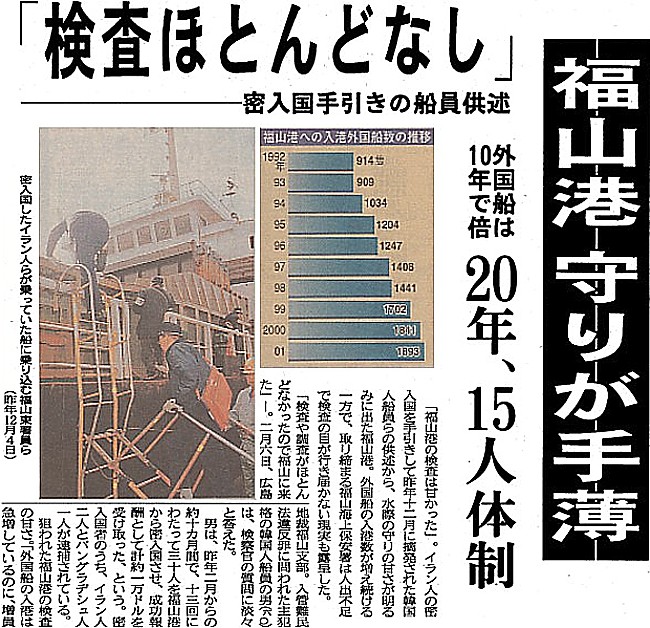
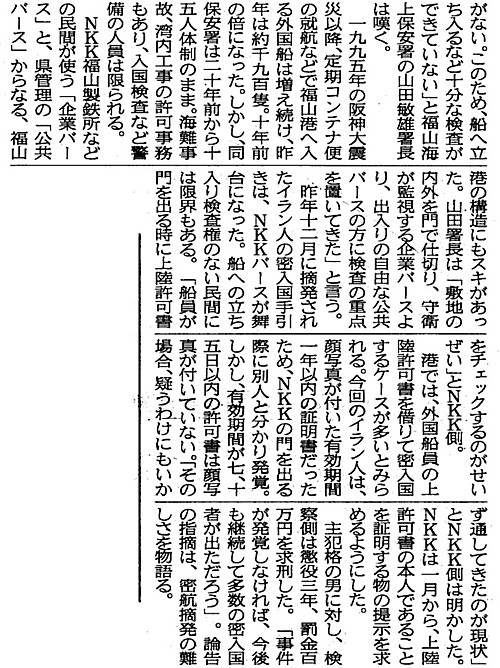
次の更新まで続く。
技術倫理について書かれたHPがあります。少なくとも虚偽の内容を書くような造船所は このような技術倫理などないのでしょう。
|
◆サブスタンダード船
◆サブ・スタンダード船と旗国の関係 ◆なぜ、サブ・スタンダード船? ◆サブスタンダード船の見つけ方 ◆検査会社の問題 |
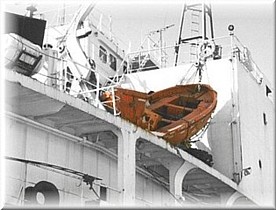 ★HOME |
◆海運関連業界
◆なぜ、サブ・スタンダード船? ◆BLUE OCEAN(ブルーオーシャン)の事故 ◆座礁船及び放置船 ◆PSCによる検査の現状 |
|---|
リンク先の中には繋がらないものもあると思いますが、ご容赦ください。

